Our Uzbekistan (or “Ozbekiston”, as the locals pronounce it) trip was the part of 17 day Central Asia trip that covered Uzbekistan, Tajikistan, Kazakhstan and Kyrgyzstan. It is a country rich in history and the birthplace of Babur, the founder of the Mughal dynasty in India. As a country, Uzbekistan was a part of the USSR until 1991 when the USSR collapsed. The country achieved independence from the Soviet Union in 1991 and became a sovereign country with pretty much the same borders when it was a part of USSR. We spent 6 days in Uzbekistan. We covered Tashkent, Fergana Valley, Samarkand and Bukhara. This blog covers the details of the trip and is best viewed on a laptop or a desktop.
We took a flight to Tashkent, Fergana Valley with Andijan, Margilan, Rishtan and Fergana (by train, hired car, flight), Bukhara (by train), Samarkand (by train), Samarkand to Dushanbe (by car).
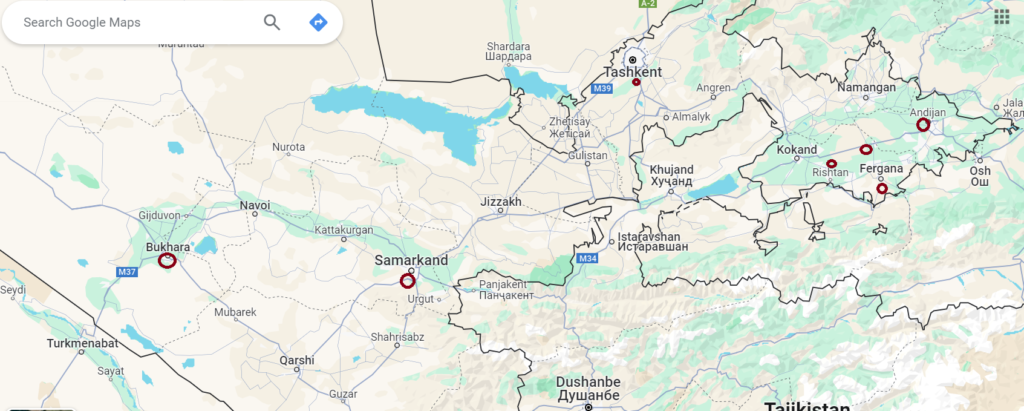
Day 1: Fri, May 17, 2024: Tashkent
We flew from Pune to Delhi by Air India Express on a 12.15 am flight and connected to Uzbekistan Airways flight leaving Delhi at 6.30 am and reaching Tashkent at 9.05 am. Uzbekistan requires a visa for both US and Indian citizens, except for US citizens above 55 years of age. Immigration and customs are smooth.




Sahil and Yash had flown in from Washington DC and landed about 1.5 hours earlier. They were waiting for us at the airport.



We left the airport at around 10.15 am. We were received by Muqaddish (our guide for Tashkent) who had arrived with a vehicle to show us around Tashkent. Instead of going to our booked hotel, Central Halal Palace, we decided to proceed directly go to our guided tour of Tashkent.


We visted Hotel Ozbekistan, a soviet era hotel with typically communist architecture, functional but large. The was the only good hotel in Tashkent during the 1970s. Filmstars from India stayed here when they visited the Soviet Union. For decades, Raj Kapoor’s films Awara, Sangam, Shree 420, etc. have been known to the people of Uzbekistan. Uzbeks know Amitabh Bacchan, Shahrukh Khan, Salman Khan and their movies.

The next stop was Prime Minister Lal Bahadur Shastri’s statue in Tashkent. He had come to Tashkent in 1966 to sign the peace treaty with Ayub Khan after defeating Pakistan in the 1965 war. He supposedly passed away from a heart attack. There are enough conspiracy theories on whether he was poisoned, but there was not enough investigation done.

We stopped at a local coffee shop. Uzbek currency som was approximately 12,500 som to 1 US dollar. Coffee was around 15-20K som (about 1-2 USD).
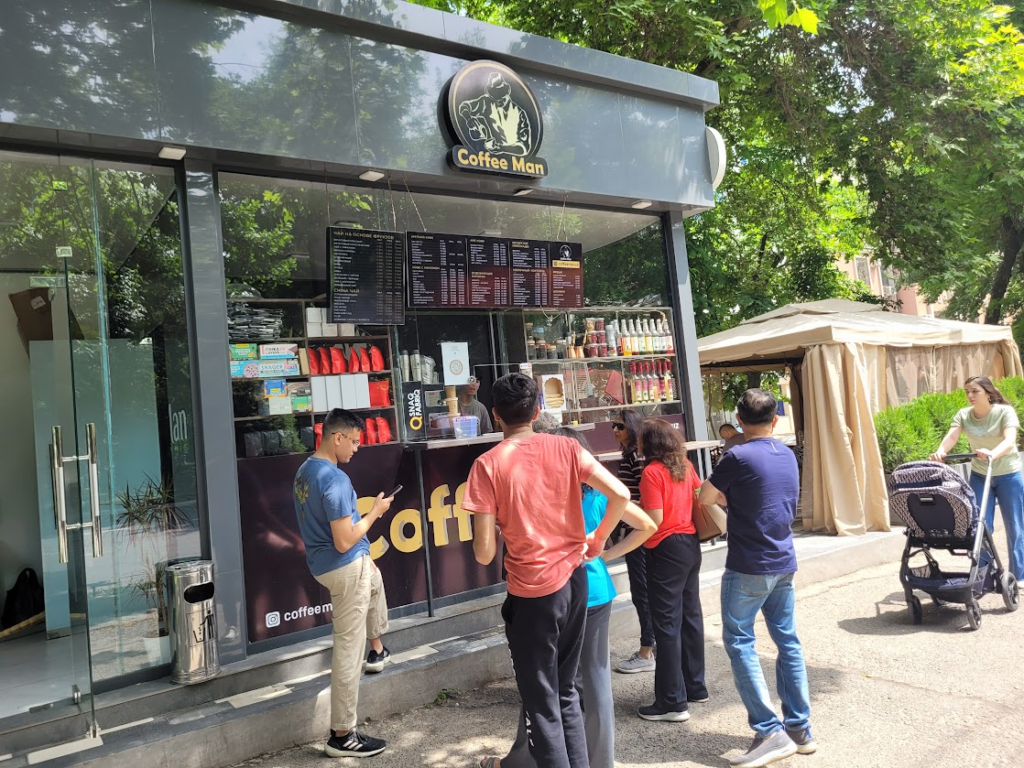
We proceeded to visit the Och (white) mosque (also known as the Minor mosque) completed in 2014. Minor mosque differs from old brick mosques with its white marble finishing. It shines under the clear sky and its turquoise dome seems to be vanishing in the sky. Its capacity is more than 2400 people. The Minor mosque is divided into parts: the open front part with terraces, and big round hall with gold plated mihrab (a semicircular niche in the wall of a mosque that indicates the qibla (the direction of the Kaaba in Mecca and the direction Muslims should face when praying), adorned with writings from Koran.


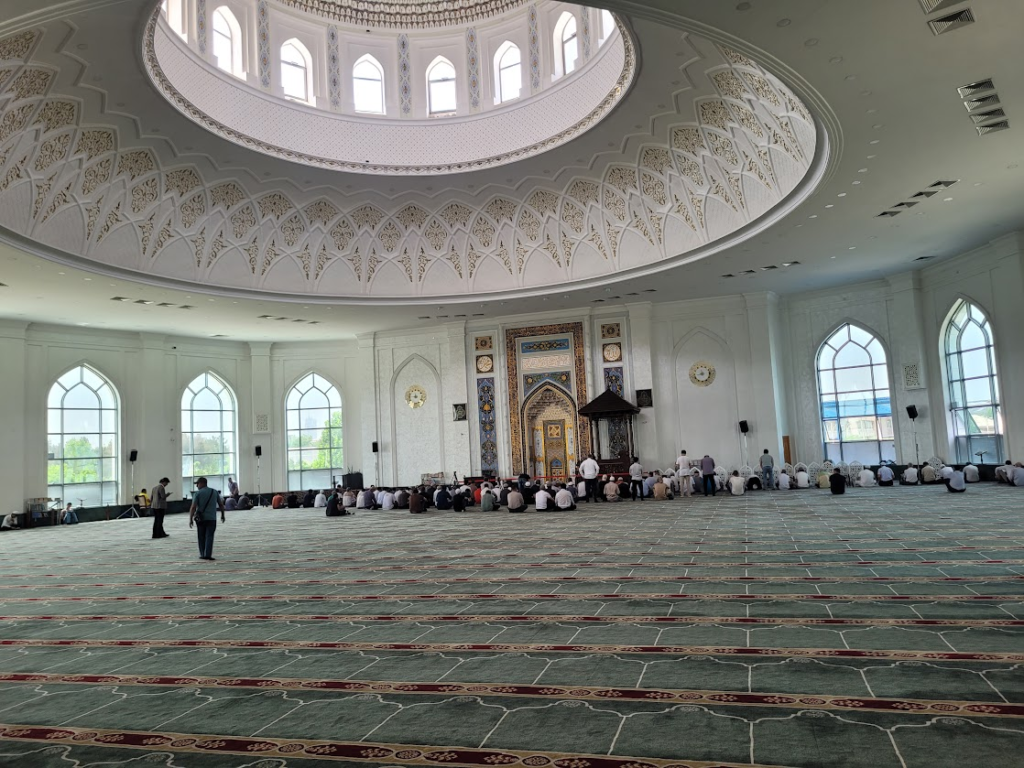
As we stepped out of the Minor mosque, we saw a street vendor selling some local drinks. We decided to try them. We had Ayran (buttermilk), Guja (buttermilk with corn and wheat) and Urik sharbati (apricot: very sweet). Very interesting to taste the local drinks. We took a photo with the lady vendor. In general, people were very curious about Indian visitors.
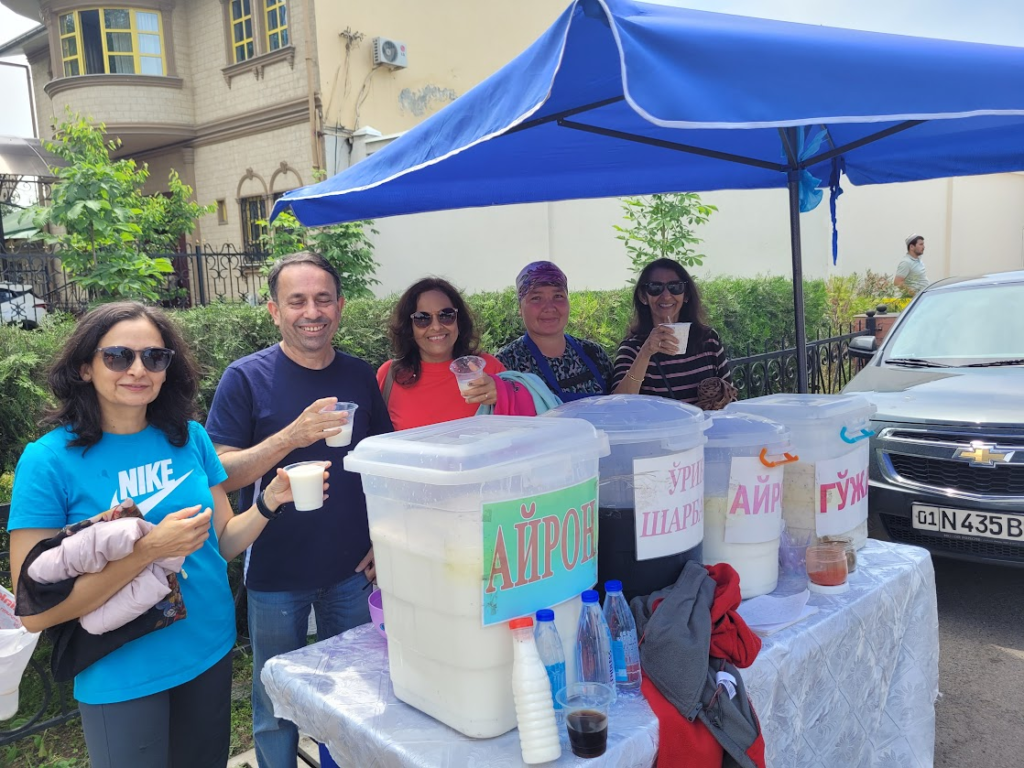
From the Minor mosque, we went to the Monument of Courage in memory of the April 26, 1966 earthquake in Tashkent which was 5.2 on Richter scale. The monument consists of a statue of a family of father, mother and child, with the father shielding his wife and kid with an expressions that tells us that they are not afraid of the earthquake. A lot of people came from the other SSRs of the USSR to help and then many stayed on in Tashkent.
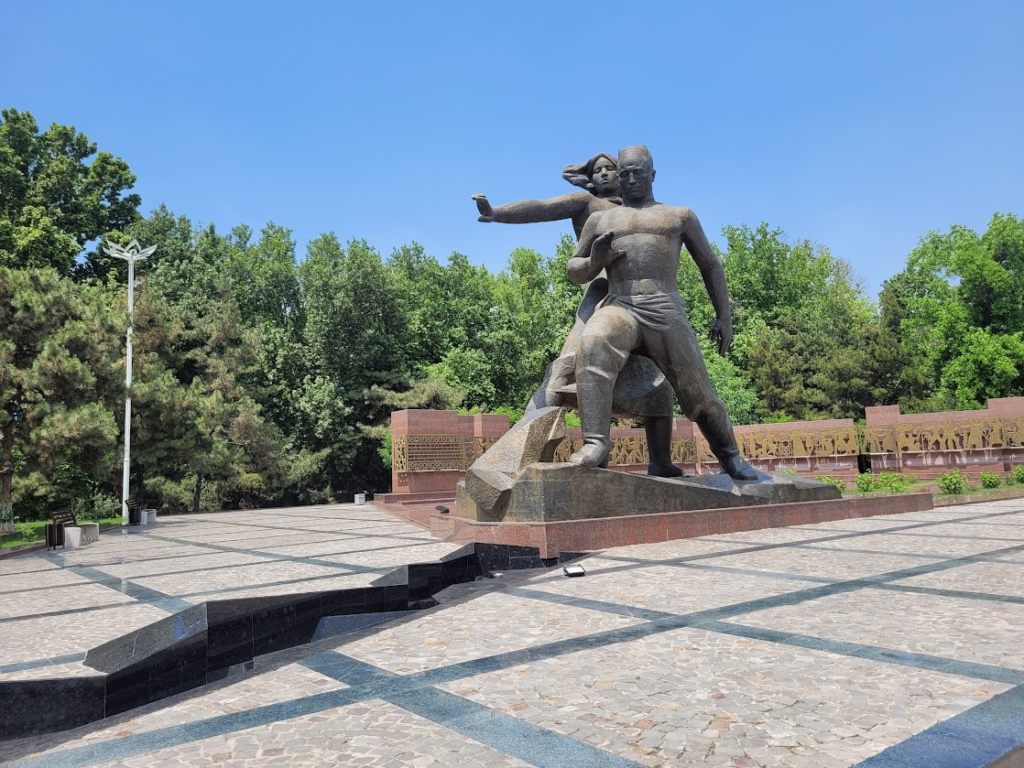

We did a quick visit to the Kokaldash Madrassa in Tashkent. The madrasah is built of yellow brick, and has a traditional square shape with a big portal and an inner yard. The walls around the inner yard contain cells inhabited by the students. During medieval times, Madrassa was simply a school or university for teaching various subjects including math, science, geography, as well as the study of Islam. It is unfortunate that nowadays, Madrassas are associated only with Islamic teaching and often as indoctrination places for terrorists.
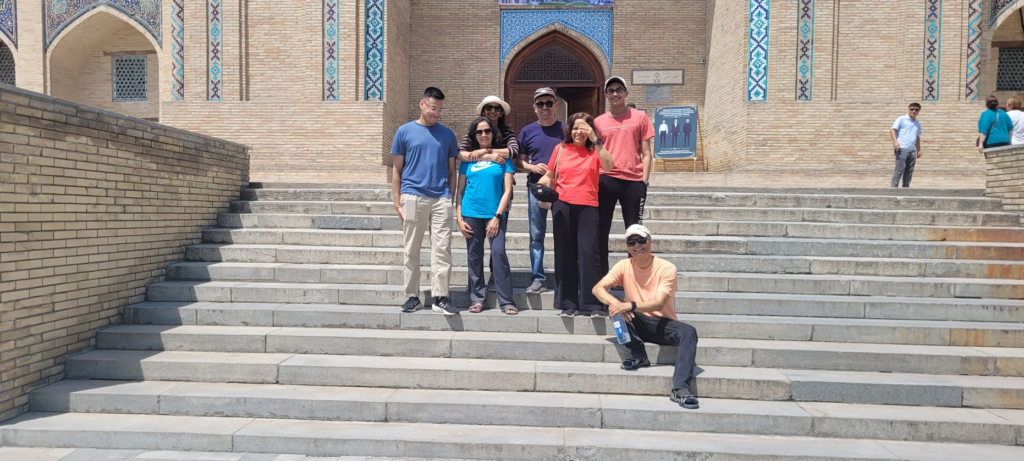

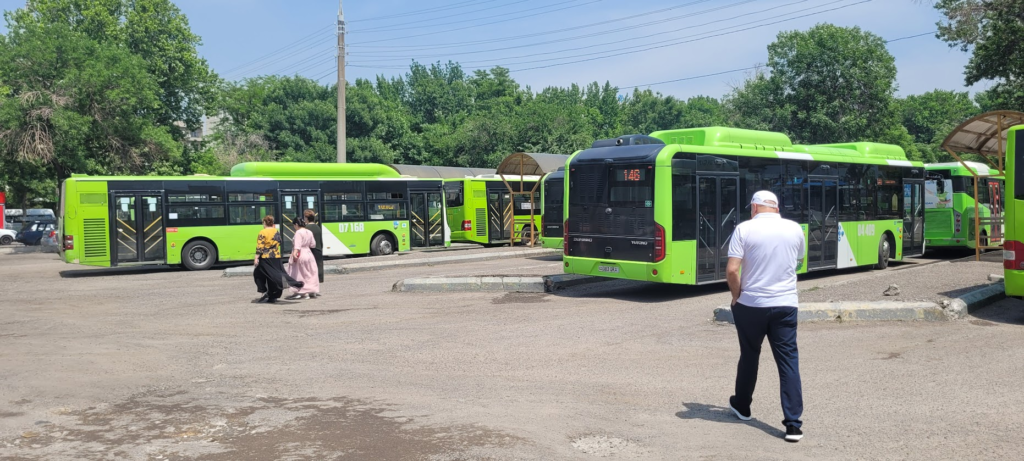
Our next stop was Chorsu market (“chor” is four and “su” directions, so 4 directions). This is a market for clothes, fruits, veggies dry fruit, different types of bread and home made foods. We went around the market to get a feel for it. Our group tasted different dishes like Khanum: potato pasta with tomato sauce (delicious) , horsemeat cutlet, lamb/beef kebab, lamb puff.
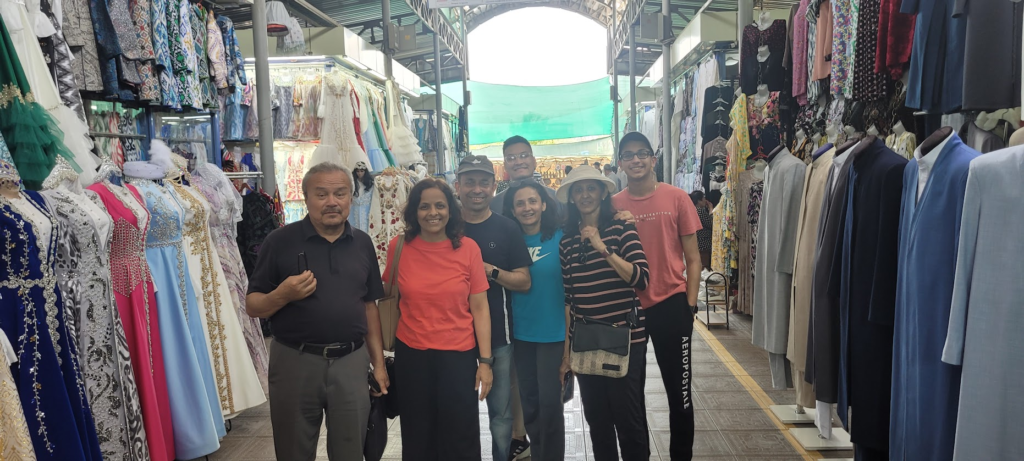

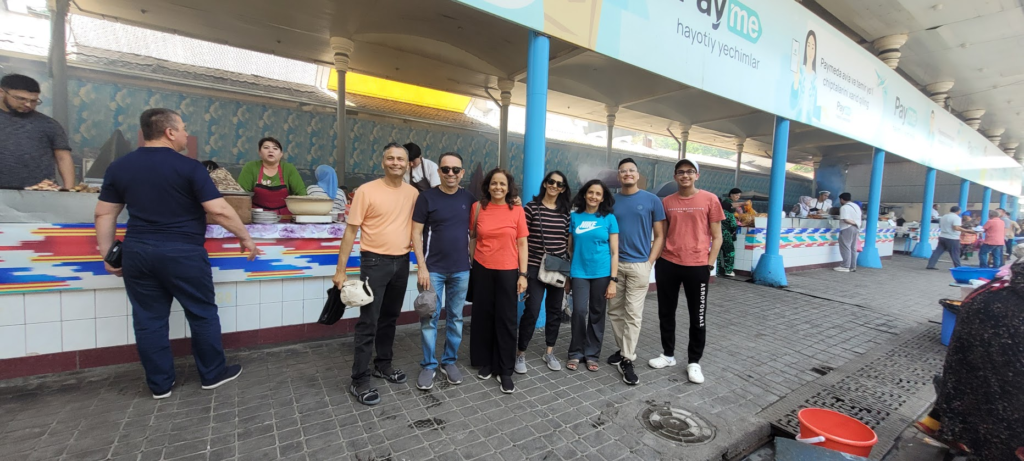

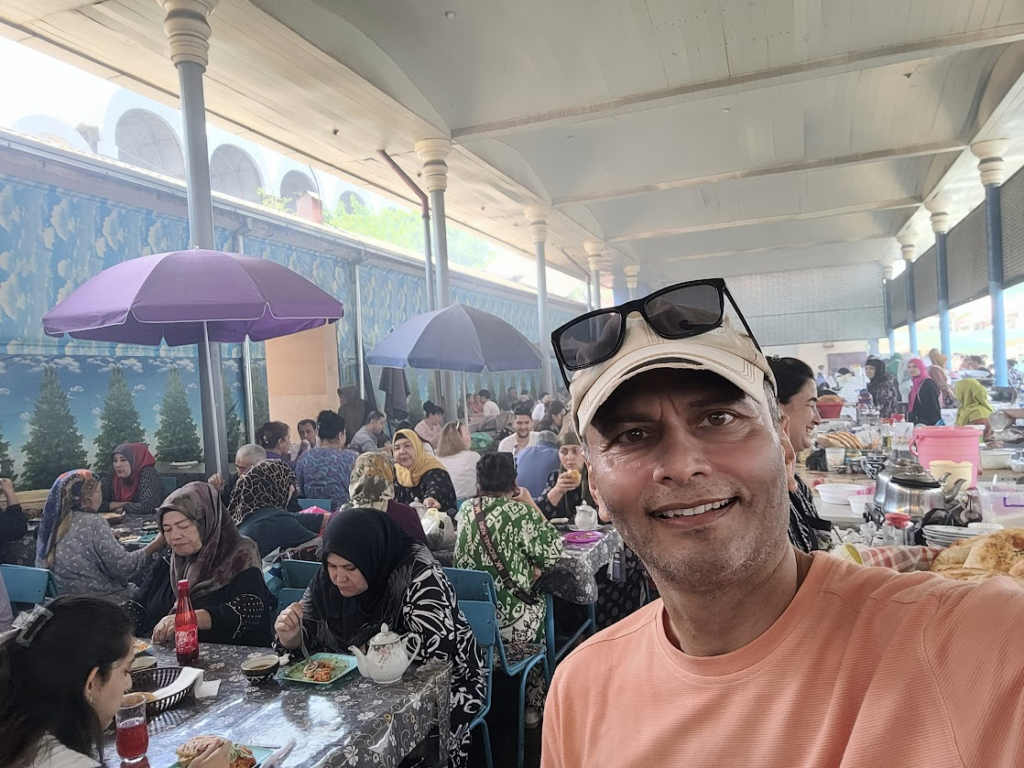


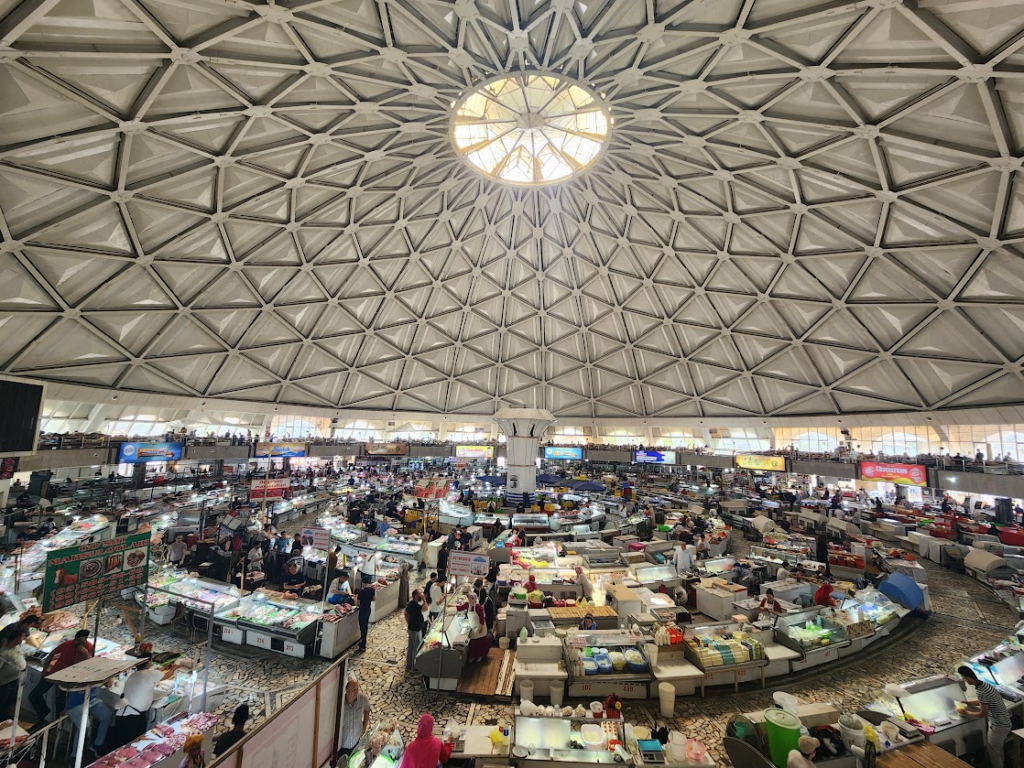
Around 3 pm we arrived at the Hazrati Imam complex which houses various places of interest. Hazrati Imam, the first imam-khatib of Tashkent, a scholar, one of the first Islamic preachers in Tashkent, a poet and an artist. According to historical sources, Hazrati Imam was also a master of making locks and keys, for which he received the nickname “Qaffol”, meaning “locksmith”. He also spoke 72 languages and translated the Old Testament (Torah) into Arabic.
The first building housed the tombs of Hazrat Imam & a couple of his disciples. It also housed tombs of 3 other important dignitaries.

The next building was the Hazrat Imam madrassa and mosque.
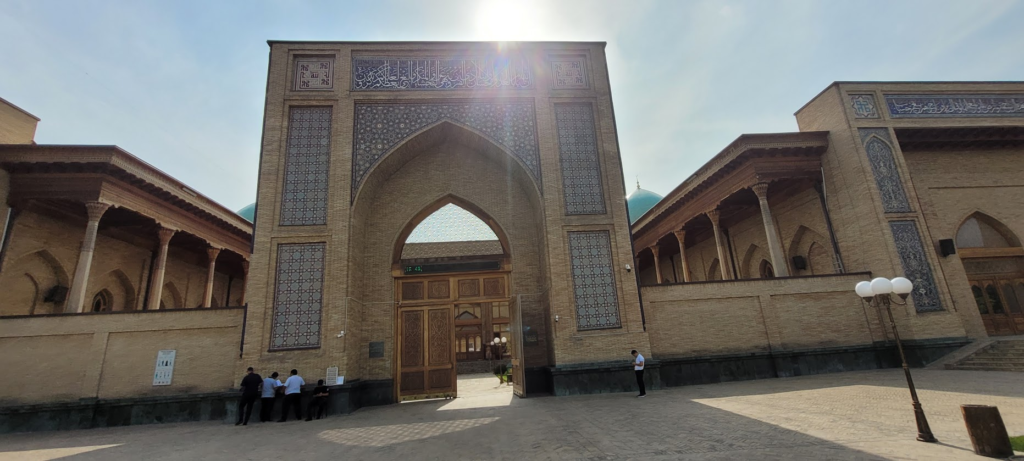
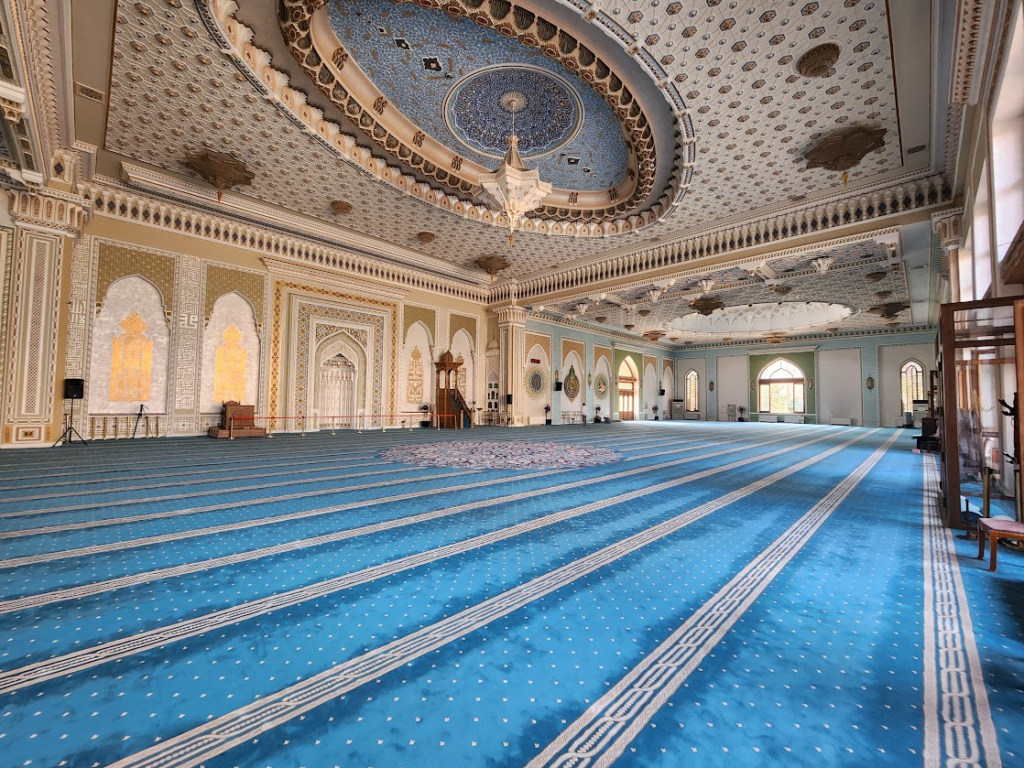
The most important sight was the the Library which houses one of the 4 original Korans dated 7th century written on deer skin in Arabic. Muqaddish (our guide) also talked to us about Hadith which is the interpretation of the Koran by scholars. In our discussion, we mentioned 4 levels of self realisation in Islam: Shariat (living life according to the text of the Koran), Marifat (knowledge through experience), Tariquat (spirtuality) and Haqiqat (knowledge that comes from communion with God). There was a 50,000 som (4 USD) ticket to enter the library.

After seeing the ancient Koran, we were all quite tired. We had not had time to eat a proper meal. We drove around to see some government buildings, the Alisher Navoi Opera theatre, Independence square also called the Lenin square during the Soviet rule, Amir Timurs statue.
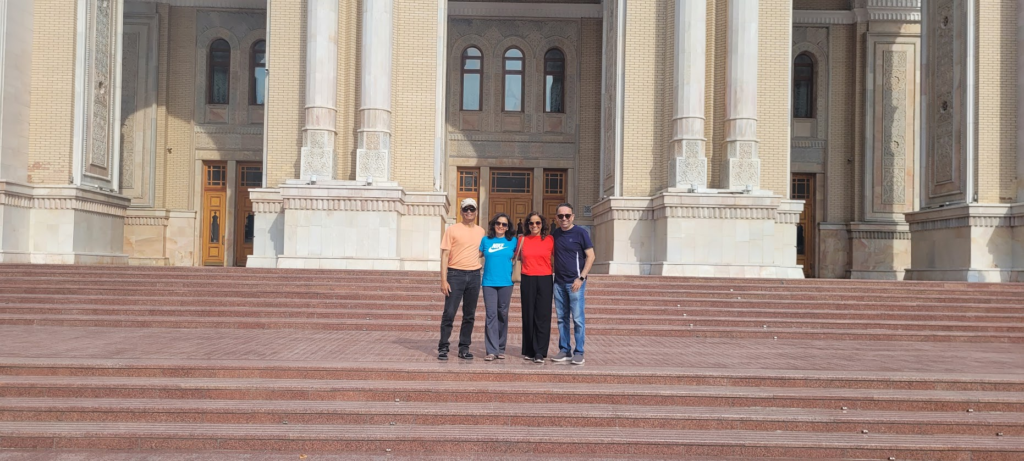
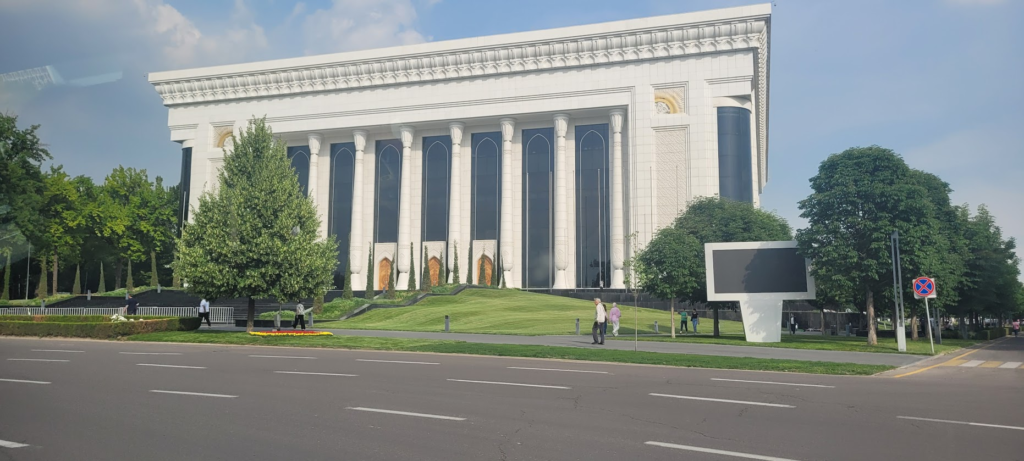
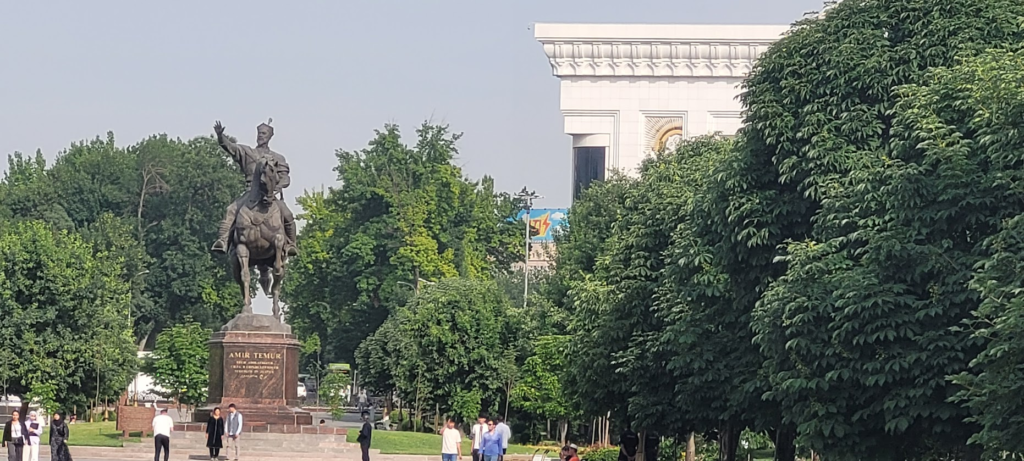
We ended our tour at the Cathedral of the Assumption of the Virgin, a Russian orthodox church built in 1871. The Russian Orthodox churches are very different from the Catholic or Protestant Cathedrals found otherwise in Europe. During the Soviet times, religion was discouraged and a lot of places of worship were closed down.
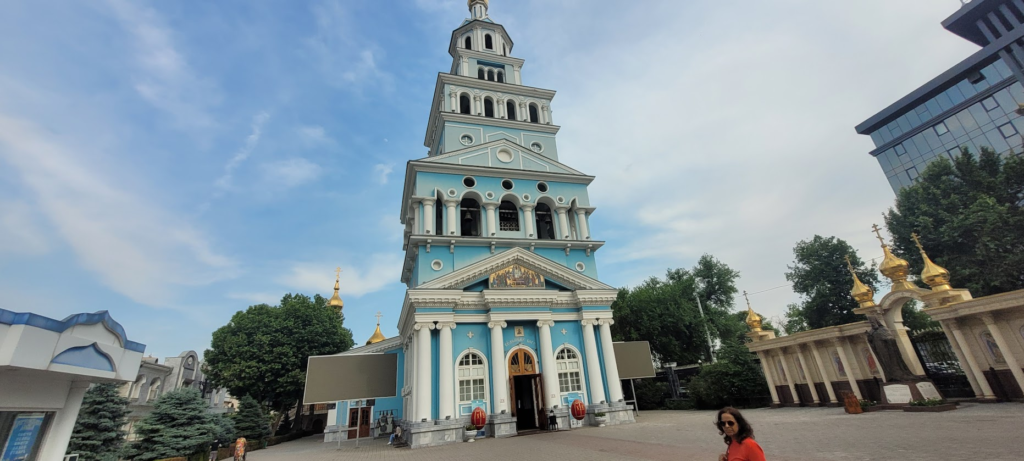
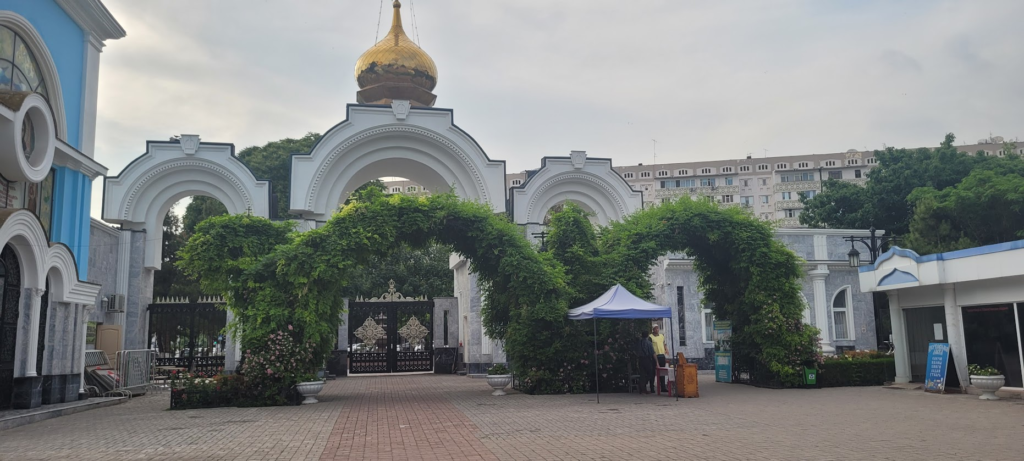
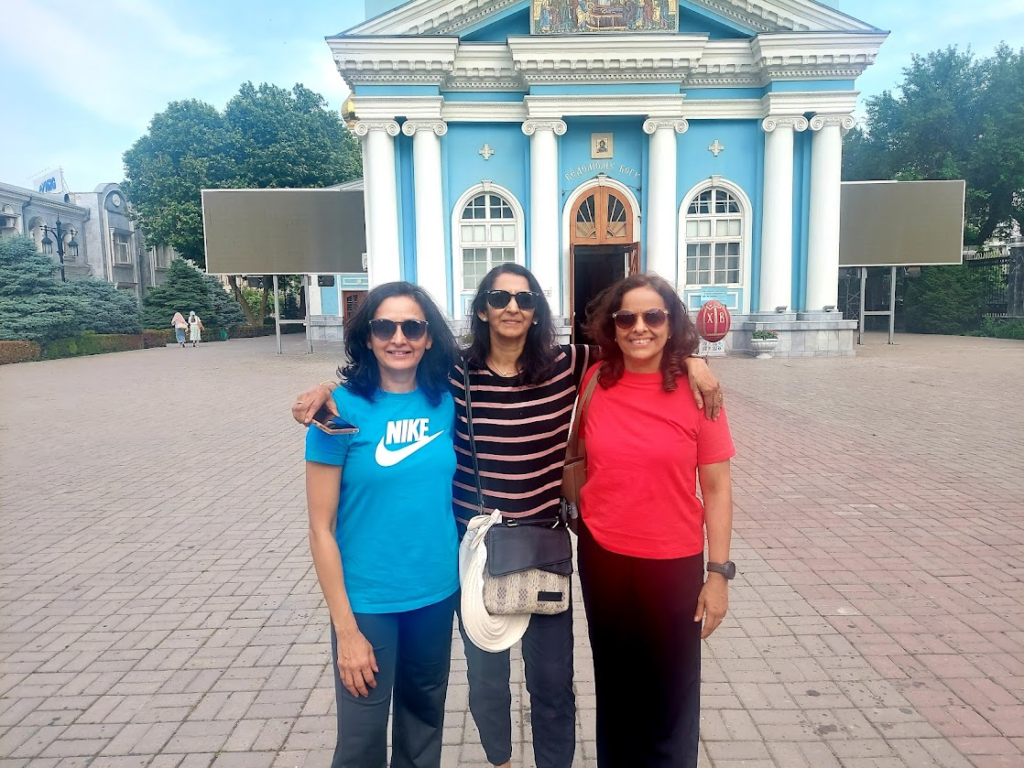
We ended the day by checking into the Central Palace Halal Hotel, a nice property in a residential part of Tashkent, very close to the Metro station.
Day 2: Sat, May 18, 2024: Fergana Valley
Located in an arid region, the Fergana valley is a fertile valley that has two rivers, the Naryn and the Kara Darya, which run from the east, joining near Namangan, forming the Syr Darya river. The economy centers around extensive cotton cultivation, a practice initiated by the Soviets, complemented by a diverse array of grains, fruits, and vegetables. Additionally, the region has a rich heritage in stock breeding, leatherwork, and a progressively expanding mining industry, including deposits of coal, iron, sulfur, gypsum, rock-salt, naphtha and some small known oil reserves.
Our train from Tashkent to Andijian in Fergana Valley was at 2.55 am. We woke up at 1.30 am. We had expected to have a hard time getting cabs, but Yandex (similar to Uber) worked great and we would get taxis within 5 mins pretty much at any time of the day. The taxis usually cost $1-3 within the city and $7 to the airport, really cheap.
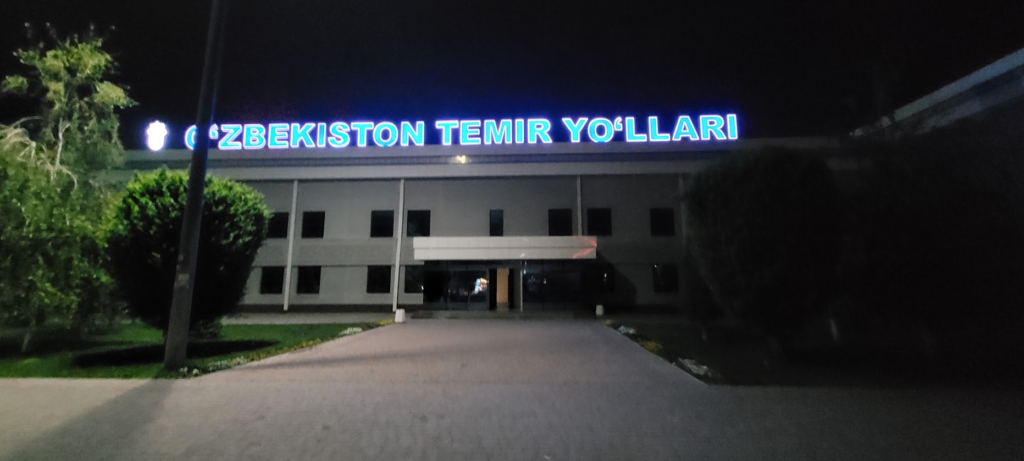
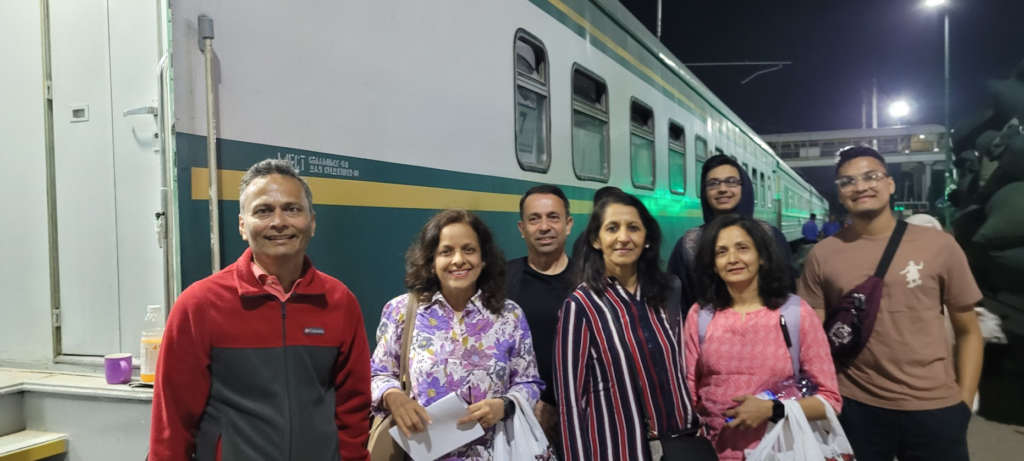
The train was a sleeper train similar to what we see in 2AC in India. It felt a little crowded, maybe, we should have gone for the upper class. But the journey was quite comfortable. They had cushioned mattresses which made the sleeping very comfortable.
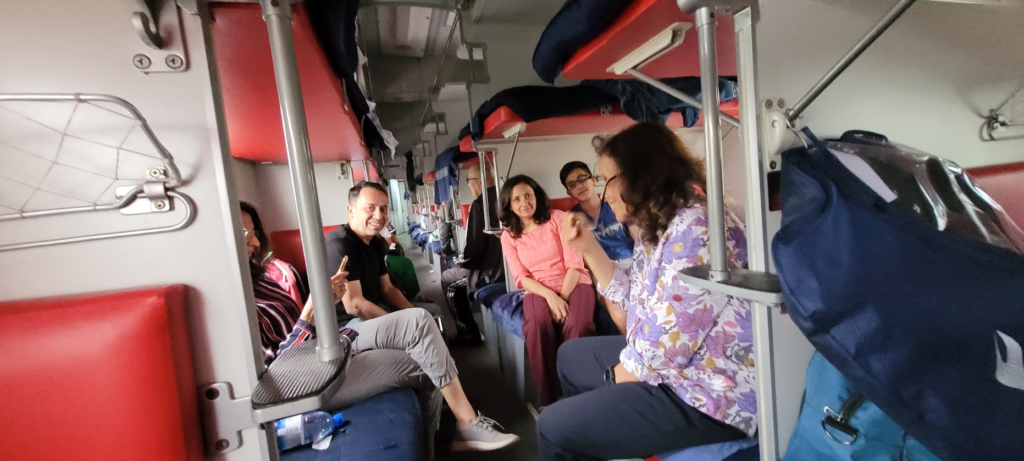
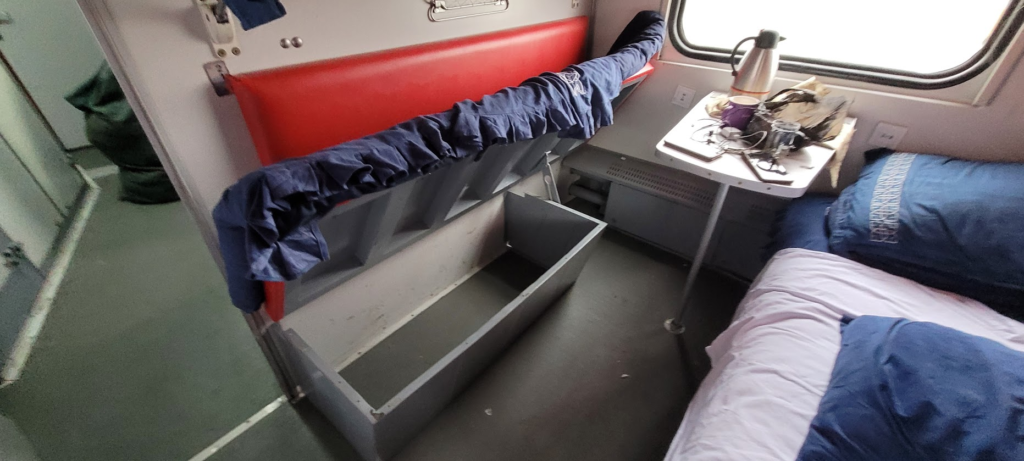
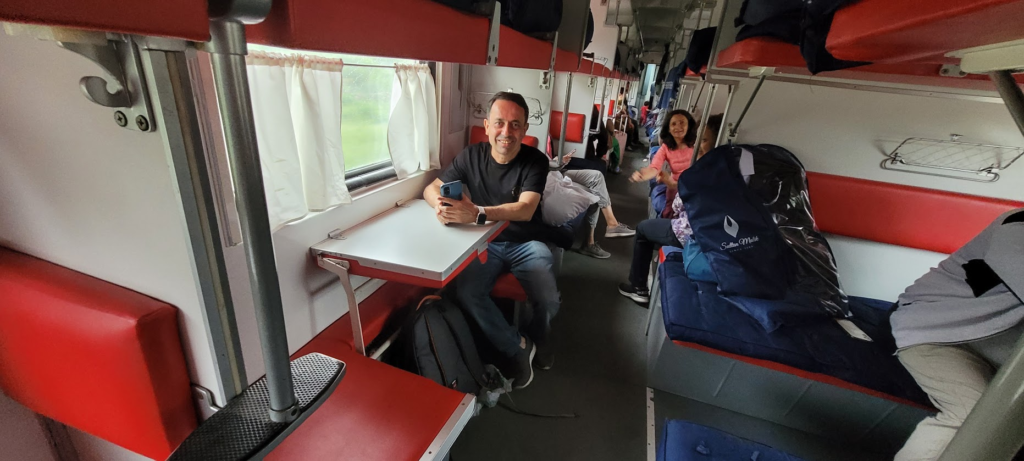
There were some nice views along the way.
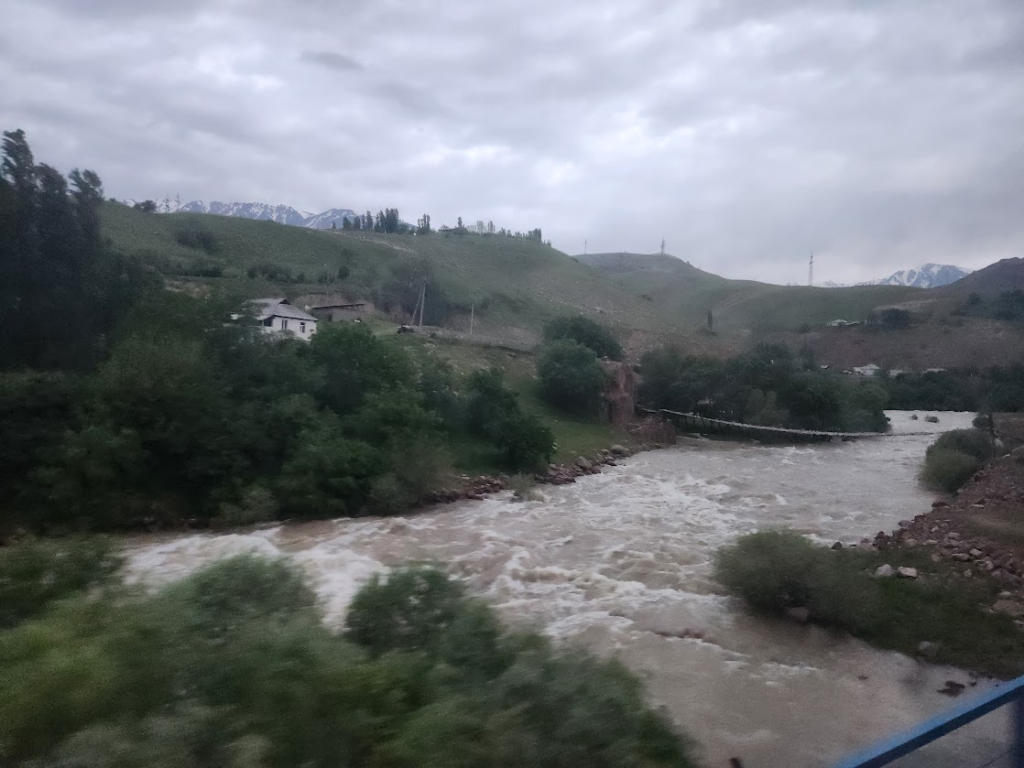
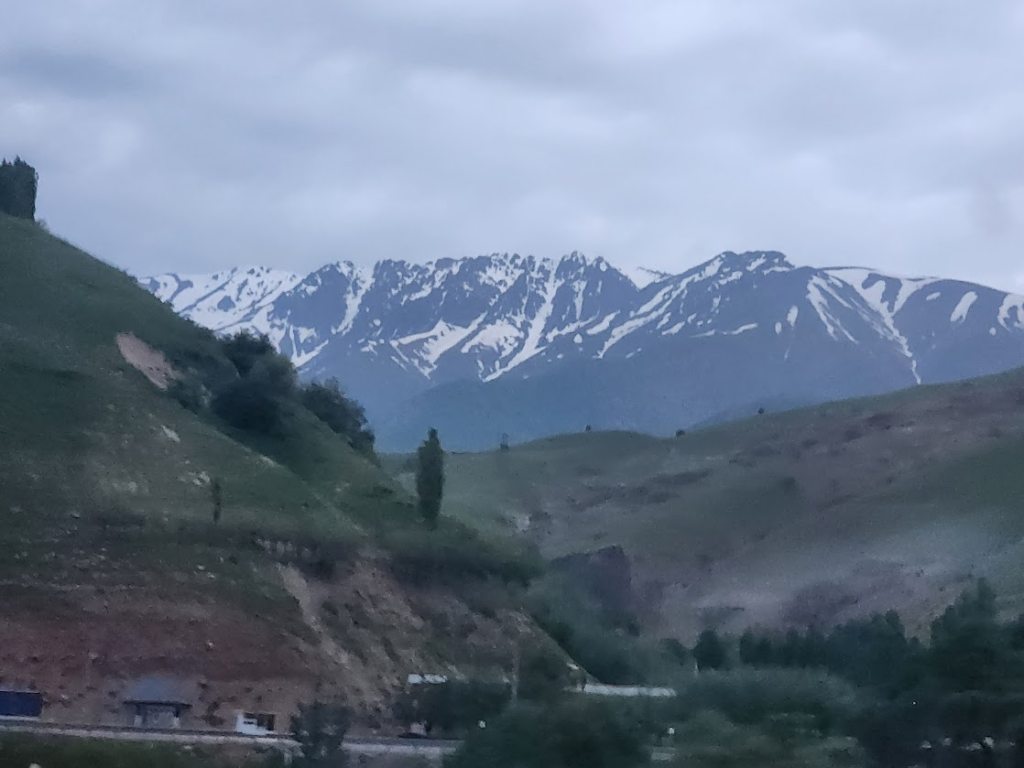
We reached Andijan at 9.15 am.
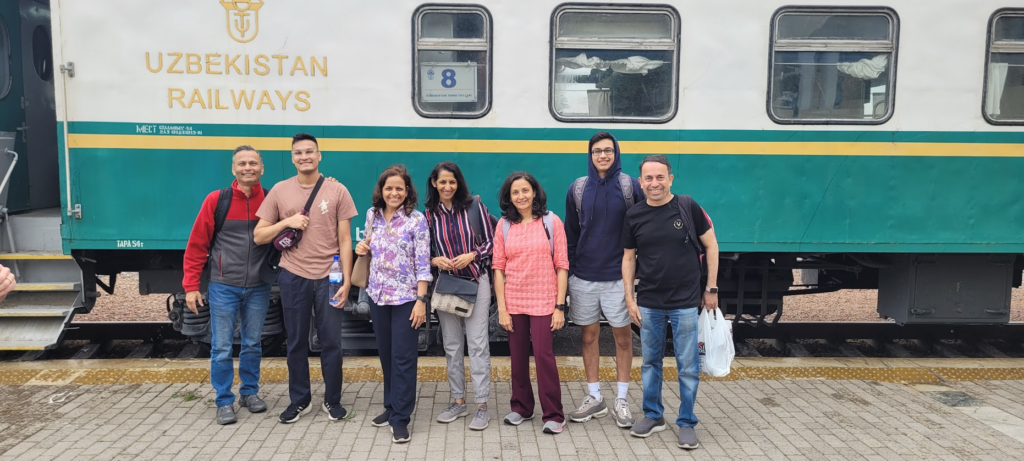

Our guide Ali was waiting for us in Andijan with the vehicle. Our travel arrangements in Uzbekistan was done by Oasis International (Owner is Mirzo Gholib, like Mirza Ghalib in India). He did a really good job at reasonable prices.
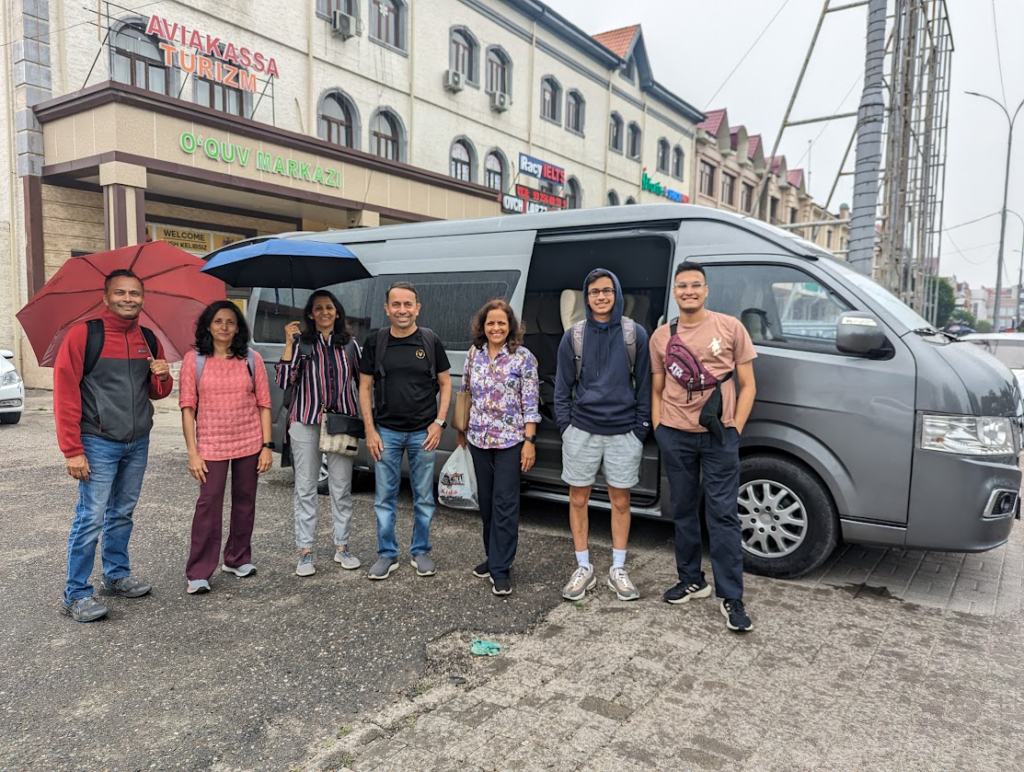
Andijan was the birthdplace of Babur, the founder of the Mughal dynasty in India. He had to flee from Andijan due to political troubles to Kabul, and then he went to Delhi. Looking at the terrain, it is hard not to admire his ability to take a small army from Uzbekistan and going all the way to set up the Mughal empire in Delhi. There is a memorial for Babur in Andijan. We visited it and took some photos. Uzbeks pronounce his name as “Baboor”.
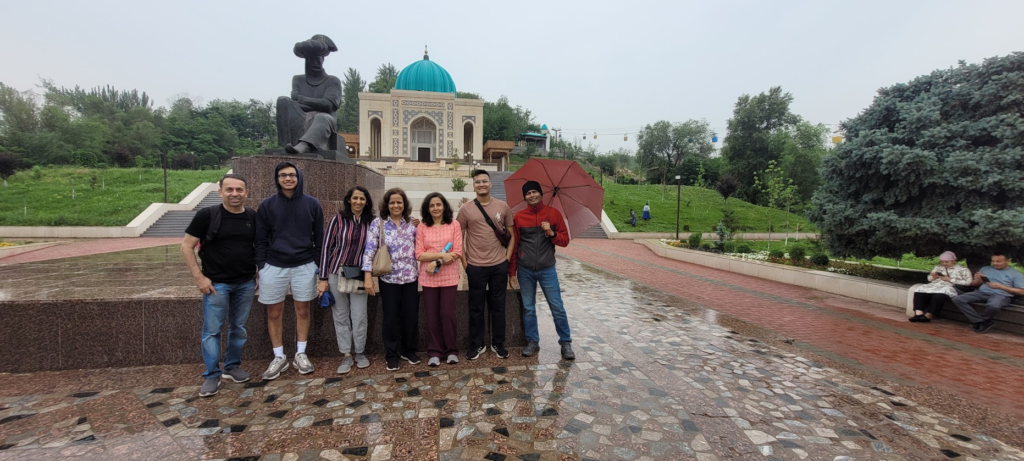

After visiting the memorial, we proceeded to visit Margilan, the center of the silk industry. We visited a silk factory. We saw a demonstration on silk making.
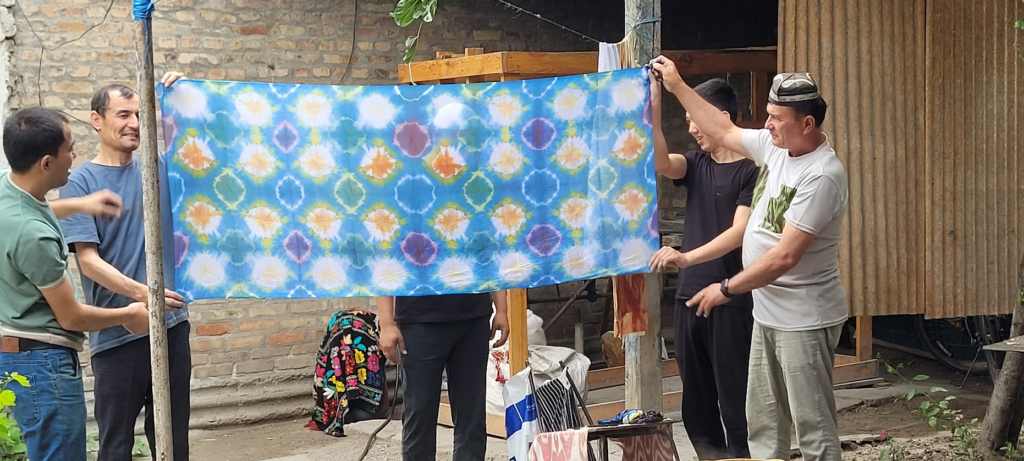
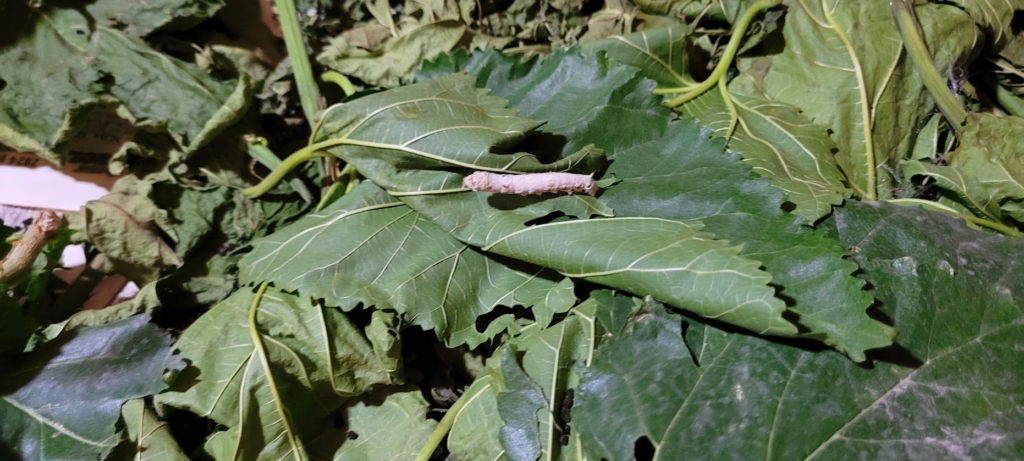

Margilan is located in the south of the Fergana Valley, where trade caravans from China traveled westwards and vice versa during the days of the Silk Road. Margilan has been renowned for its silk goods as far back as the 10th century. According to legend, Margilan was founded by Alexander the Great. While stopping for lunch there, Alexander was served chicken (murgh; in Persian) and bread (nan; in Persian), from which the town took its name. More reliable records indicate that by the 9th century Margilan was an important stop on the Silk Road, along the route going across the Alay Mountains to Kashgar.

A quick note about the Silk Route. The Silk Route was a network of Eurasian trade routes active from the second century BCE until the mid-15th century. Spanning over 6,400 kilometers (4,000 miles), it played a central role in facilitating economic, cultural, political, and religious interactions between the East and West. Generally, the silk route was divided into three branches from China towards Europe, towards the Middle East and towards India.

We stopped for lunch at a family cafe in Margilan.
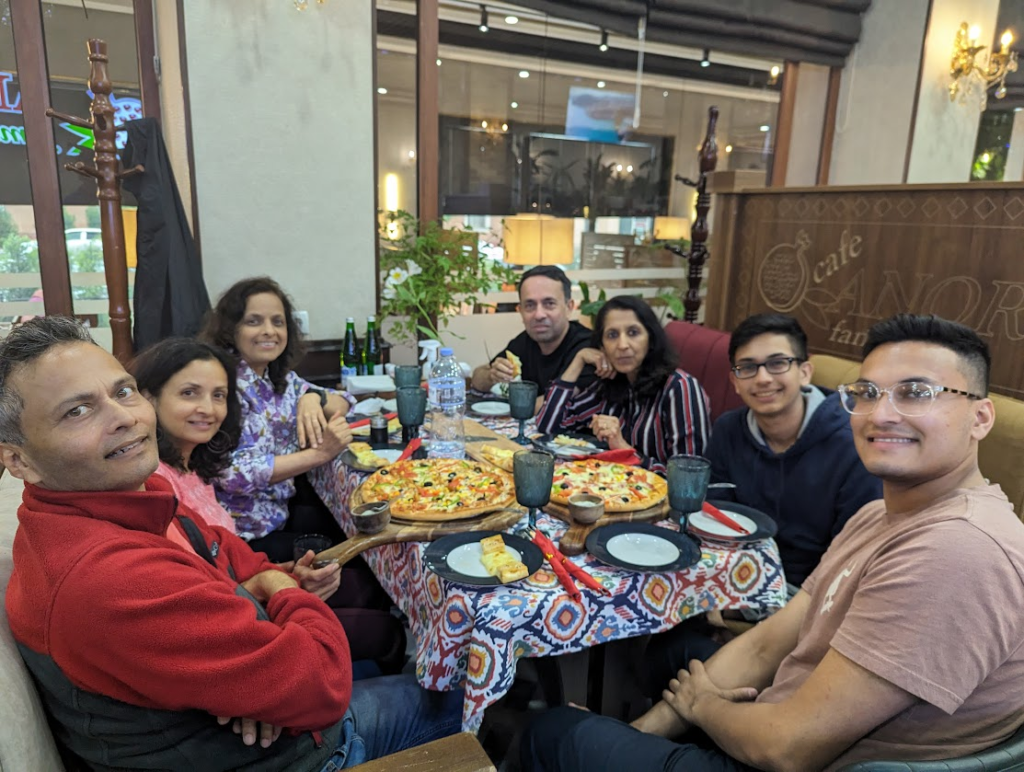
From Margilan, we proceeded to Rishton, the most famous, and one of the oldest centers of ceramics in Uzbekistan. The ceramics are made from clay, unlike porcelain ceramics from China. We visited a ceramics factory where we saw a live demonstration on ceramic making and painting.
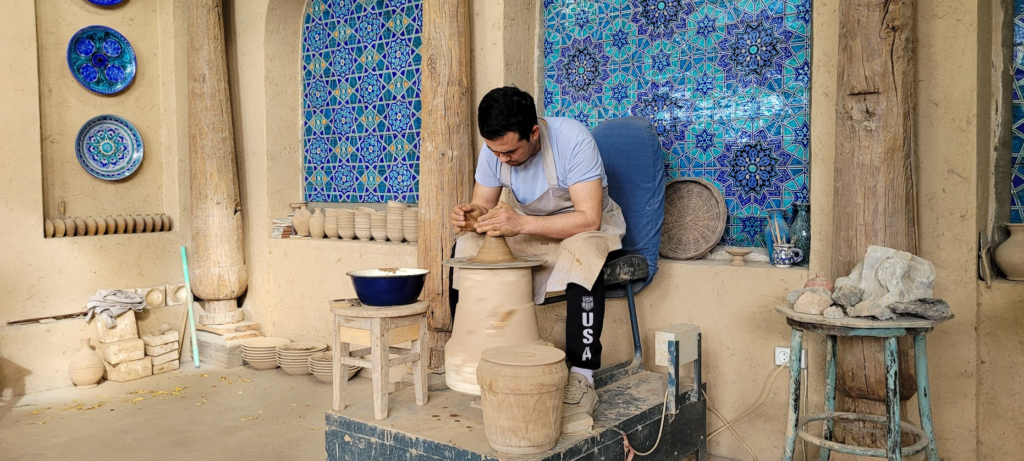
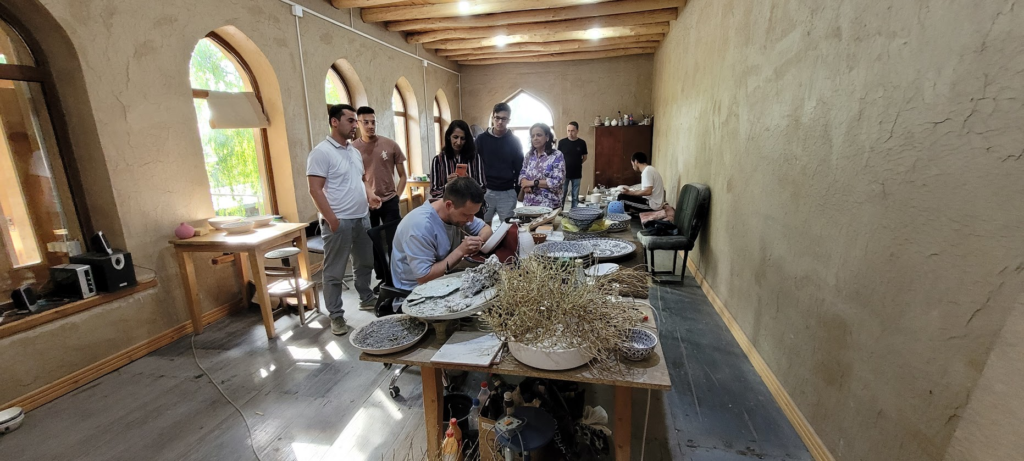
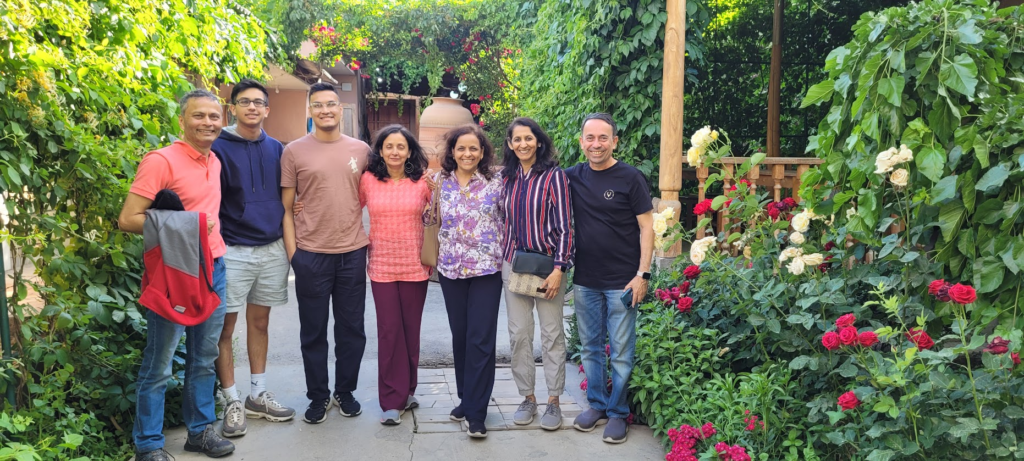
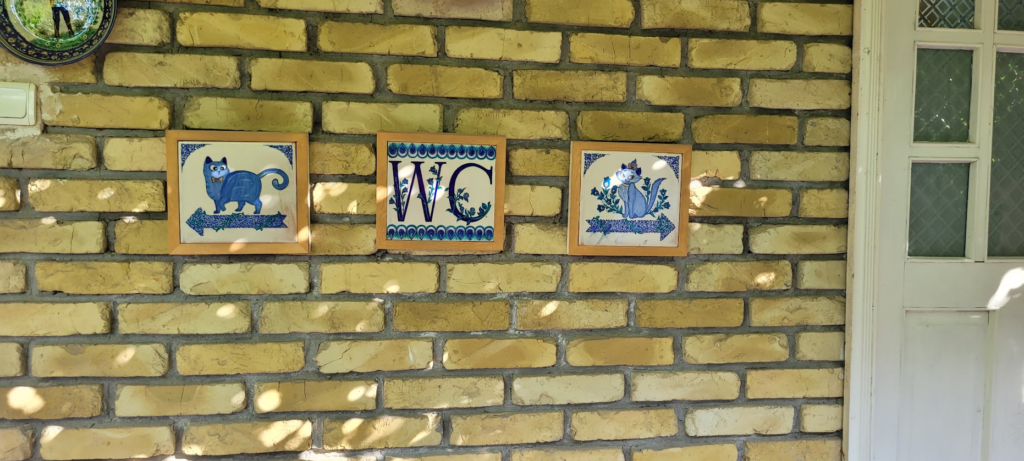
From Rishton, we proceed to the town of Fergana, a modern city founded in 1876 during Russian occupation. In Fergana, we visited the Central Park, a large amusement park. It has a huge statue of Al Farghani, an astronomer in the Abbasid court in Baghdad, and one of the most famous astronomers in the 9th century. Al-Farghani composed several works on astronomy and astronomical equipment that were widely distributed in Arabic and Latin and were influential to many scientists.
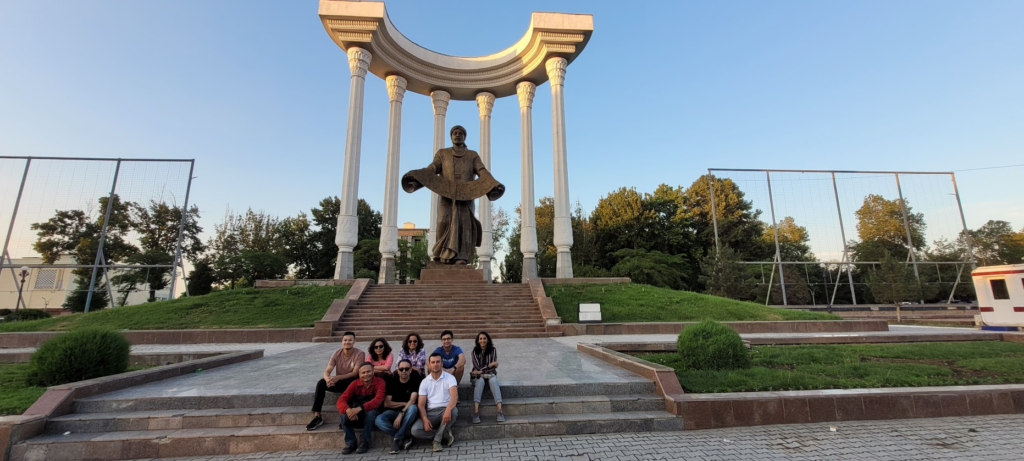
After visiting the park, we had coffee at a Turkish cafe. The service was slow, which seems to be the norm in Uzbekistan. Expect to spend a lot of time eating a sit down meal in nice looking restaurants. If you want quicker service, go to a street-side tea house which is bustling with people. We found their service to be much quicker.
We were dropped off at Fergana airport at around 8 pm. Our flight was at 9.50 pm and we reached Tashkent around 10.45 pm. The flight cost was $13 per person 🙂
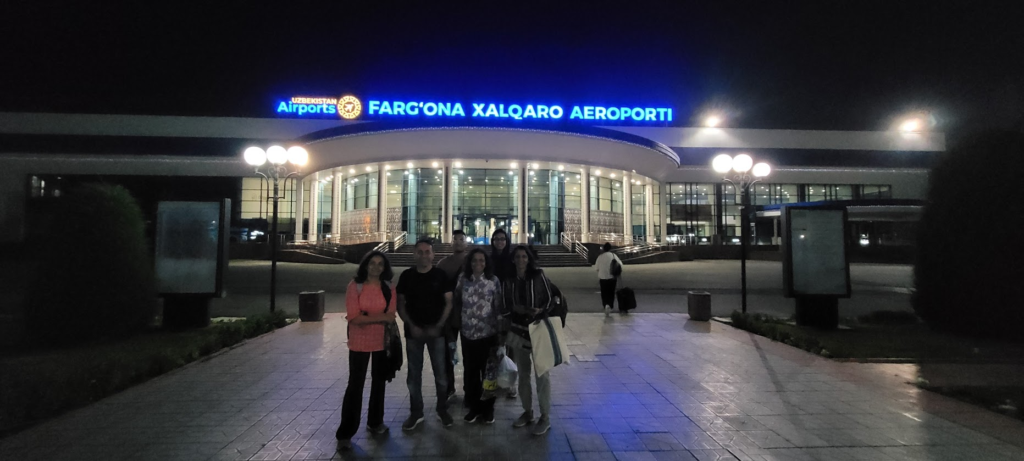
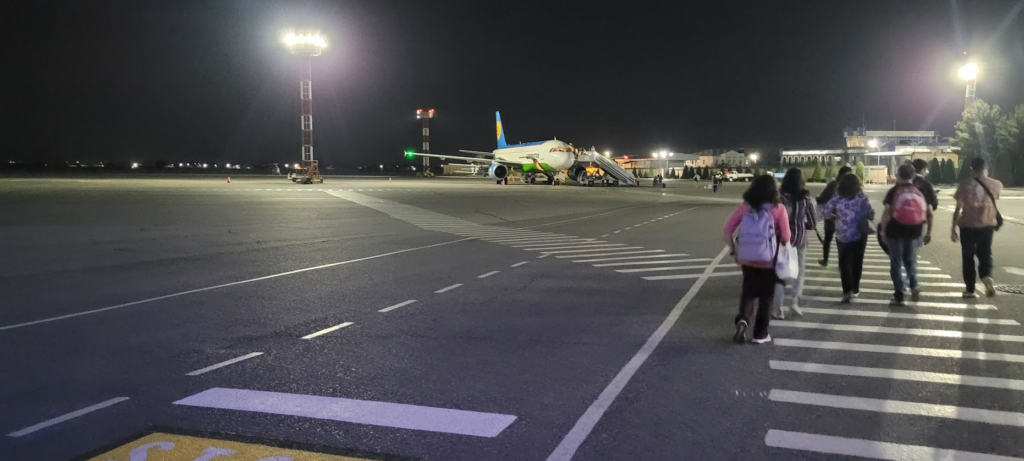
Day 3: Sun, May 19, 2024: Tashkent
This was an easy day with no specific plans. We had already covered most of the items in Tashkent. It was a rainy day.
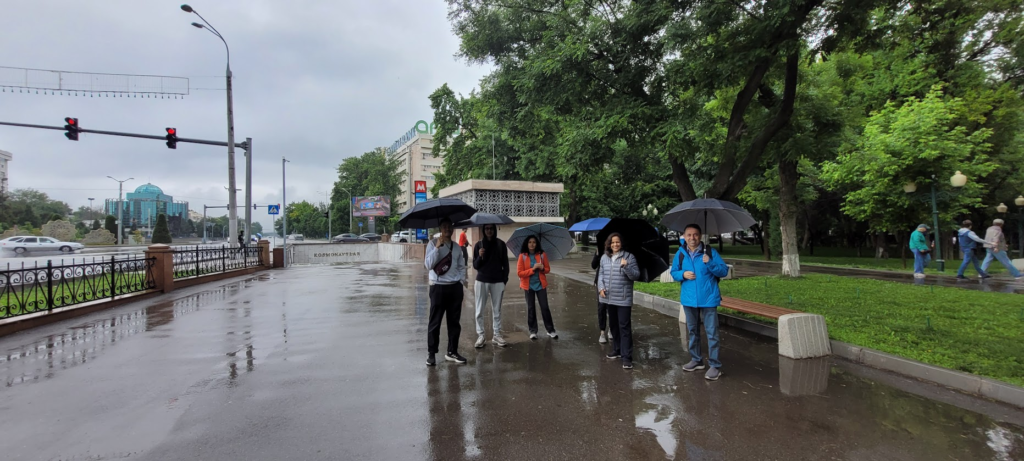

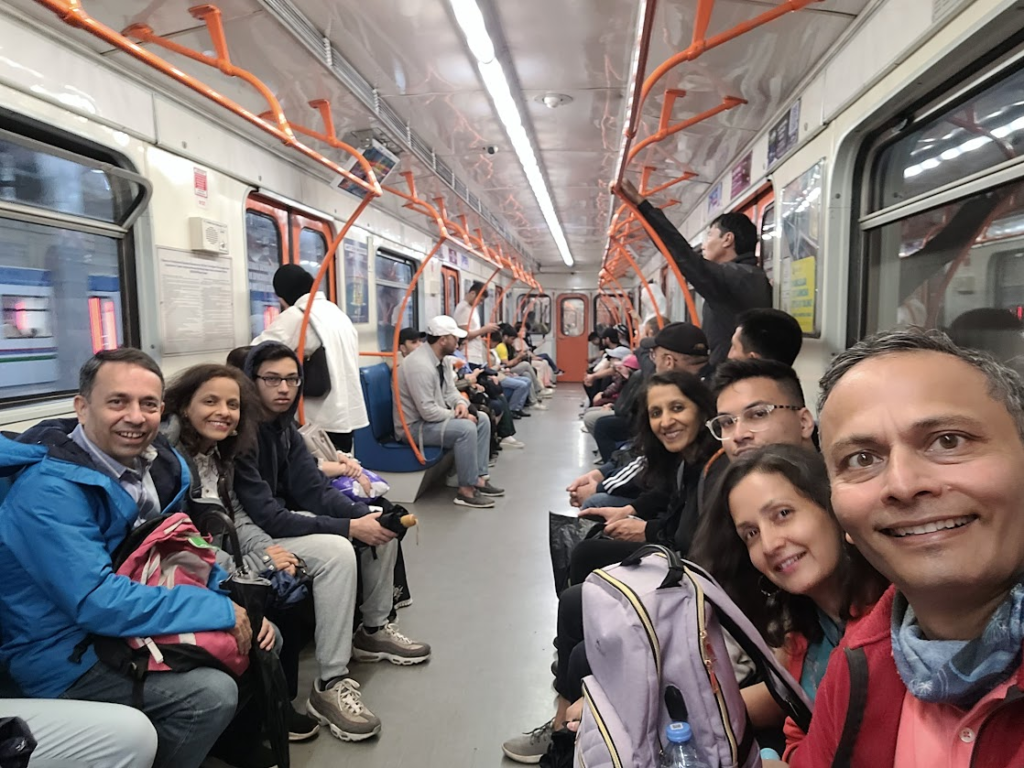
We started by visiting Independence square, called Lenin square during Soviet times. After the proclamation of Uzbekistan’s independence in September 1991, “Lenin Square” was renamed in 1992 as “Mustaqillik Maydoni”, which translates to “Independence Square” in English.
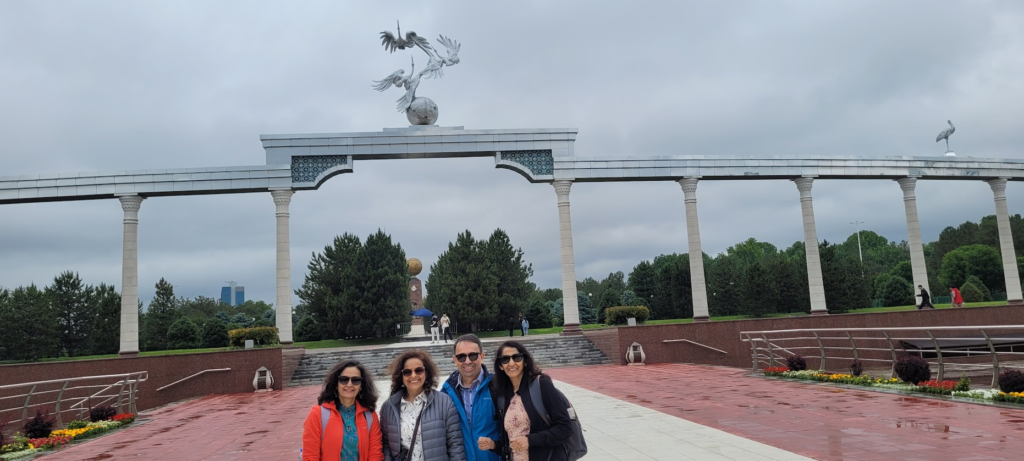


We then took the metro to Chorsu Bazaar, where Anjali was looking for bird shaped scissors. We did not find those here, eventually, they were easily available in Bukhara. We roamed around on the Metro. The cost for each ride was 1,000 som (about 8 US Cents or 7 Indian rupees). You just tap your credit card and go. The metro stations were really ornate and the trains really good. We did quite a few rides.


We then had lunch at Cafe 91. The food was decent, but as usual, the service was slow and the quantity of the food was very small.

We visited another nice site in Tashkent.
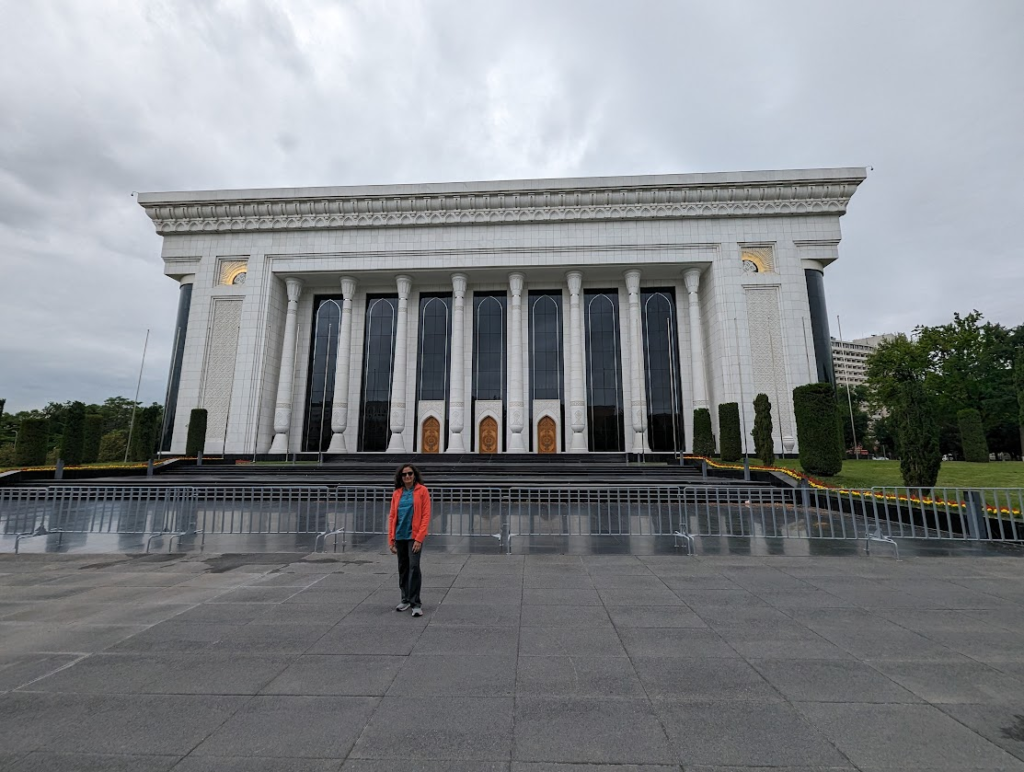
We then visited the Uzbek Museum of Natural History, which talked about the history of Uzbekistan. Sahil and I liked it quite a bit, so we spent a lot of time there. Maithili, Abhay went to the Museum of Applied Art.
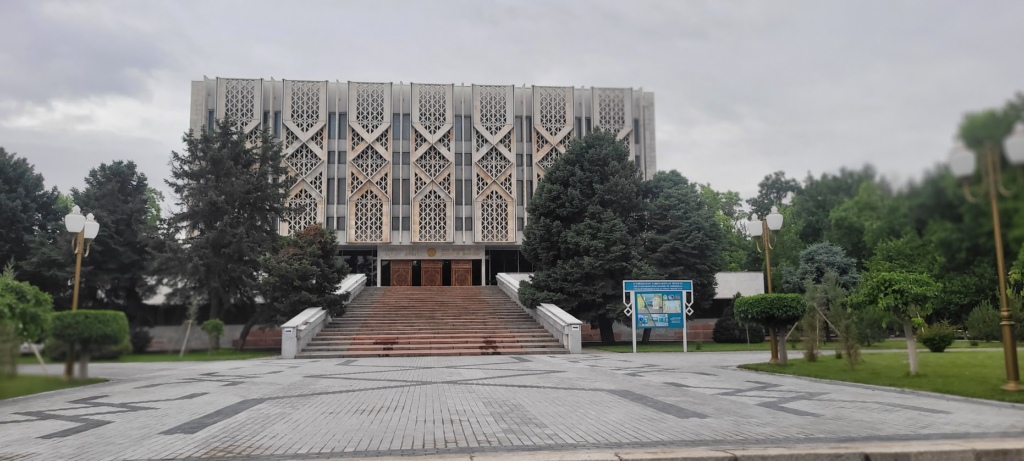

Maithili and Abhay were visiting the Museum of Applied Art in Tashkent while we continued to explore the Museum of Natural History.

From there, Sahil and I proceeded to Tashkent tower, which we reached by 5.20 pm. The Tashkent Television Tower is a 375-metre-high (1,230 ft) tower is the twelfth tallest tower in the world. Construction started in 1978 and the tower began operating six years later, on 15 January 1985. The tower had a nice aerial view of Tashkent city.

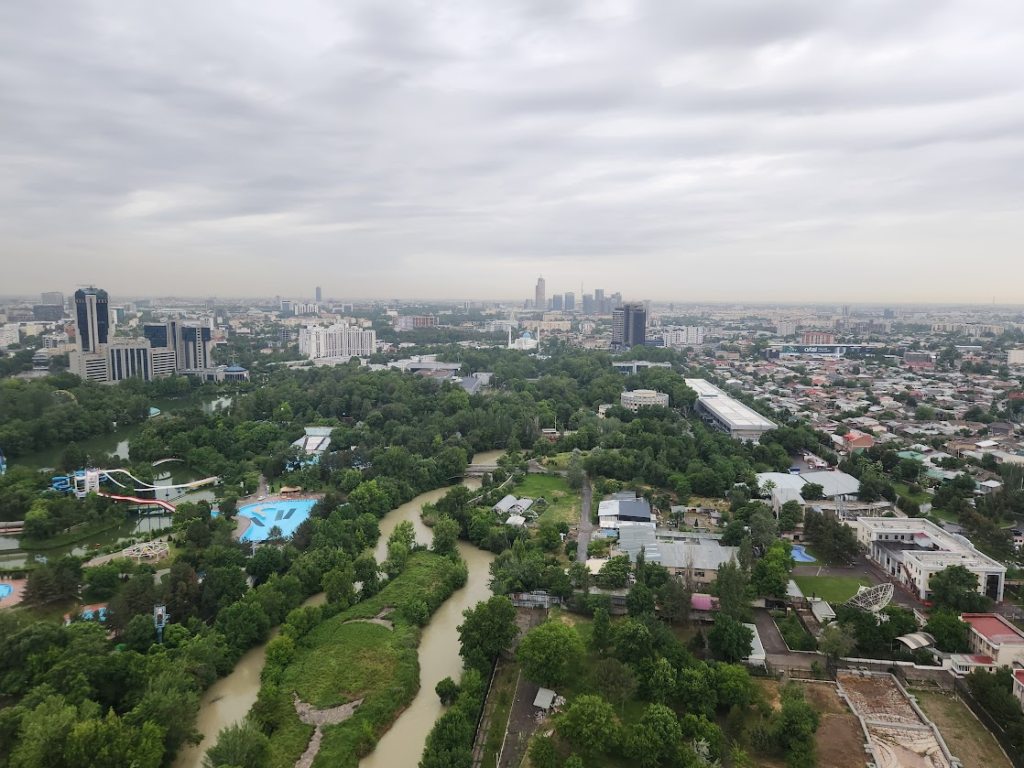

We thought it was a good idea for others to visit it as well. So we asked them to join us. That was a miscalculation. Anu, Yash and Anjali arrive at 5.50 pm. Maithili and Abhay arrived at 6.05 pm. We came down from the tower at 6.25 pm. Our train was at 7.20 pm.
Yash, Sahil and Samir reached the hotel at 6.45 pm. Abhay, Maithili, Anu and Anjali had booked two cabs that showed up in the wrong place, so they missed them. They ran out of time. So we asked them to book another cab and come directly to the train station. They reached the train station around 7.05 pm. Yash, Sahil and Samir picked up all the 7 bags from the hotel, took two Yandex cabs and reached the train station at around 7.10 pm. We had to go through security and we ran for the train, which we reached at around 7.15 pm. Our reservation was in coach 6, but we were asked to board in coach 4 and the doors closed at 7.15 pm, 5 mins early. We just made the train. It was a hair-raising experience getting to the train just in nick of time. That was a close call. Our visit to Tashkent tower was a huge miscalcution, we made it to the train!
The train was an Afrosiyob, high speed train from Tashkent to Bukhara. It was very comfortable, like the Vande Bharat train. We made the 571 km journey in about 4 hours, reaching Bukhara at 11.30 pm.
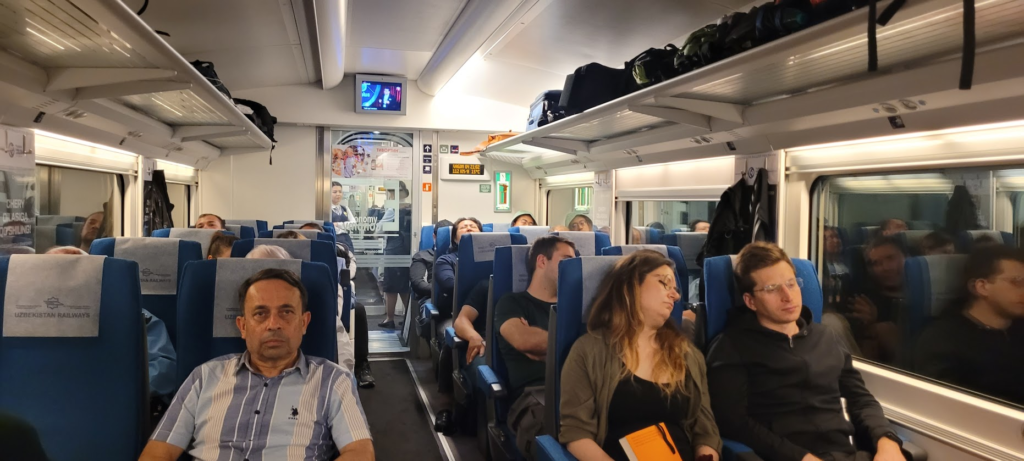
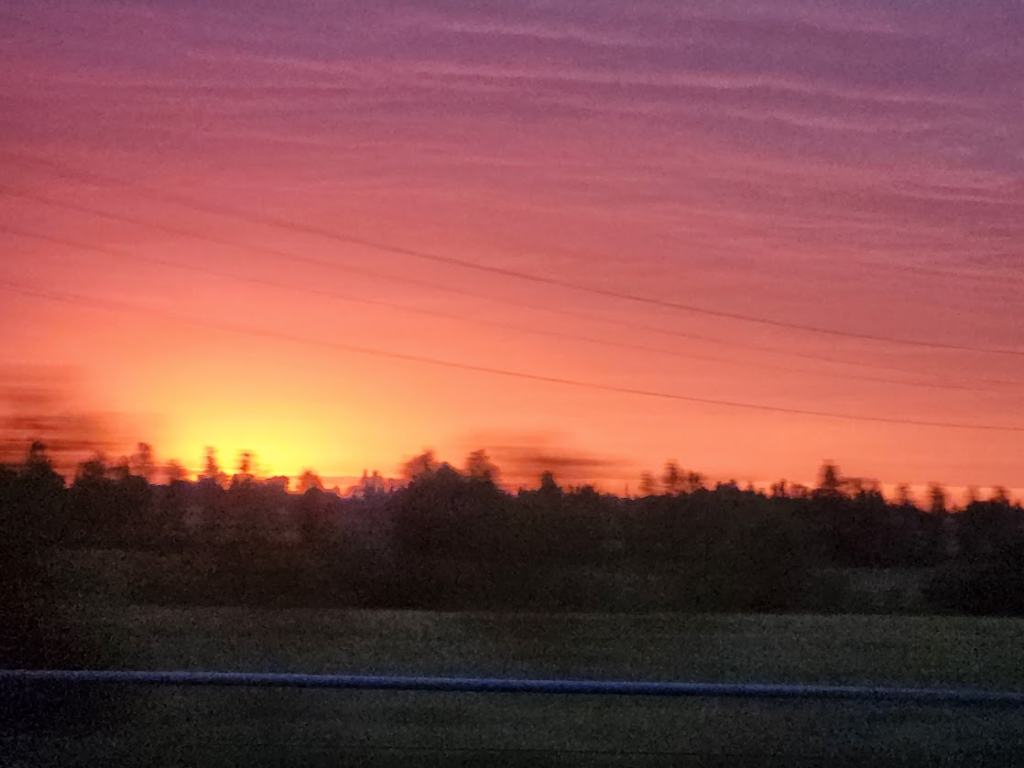
At the Bukhara train station, we were solicited by taxi drivers who said no Yandex would come. We ordered it anyways and we got two Yandex taxis within 10 mins even at that time of the night, no problem. The city of Bukhara is about 25 mins from the train station, a little far.
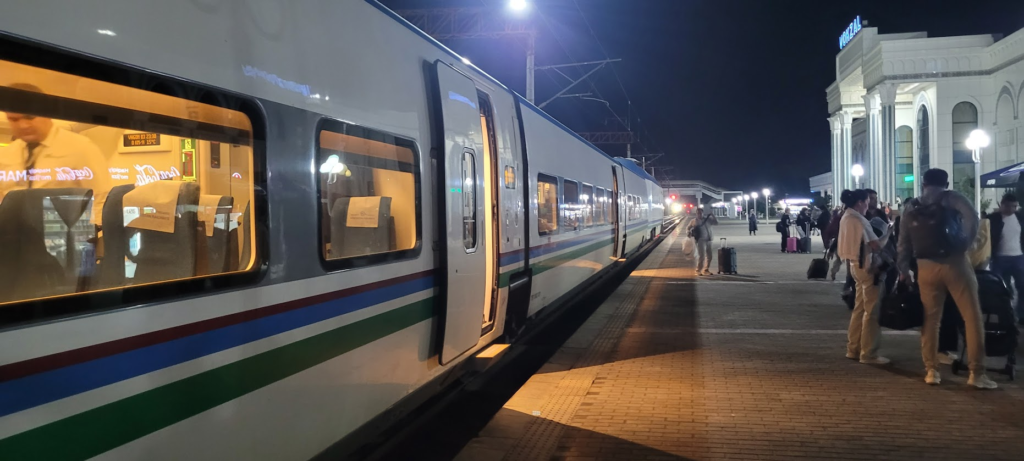
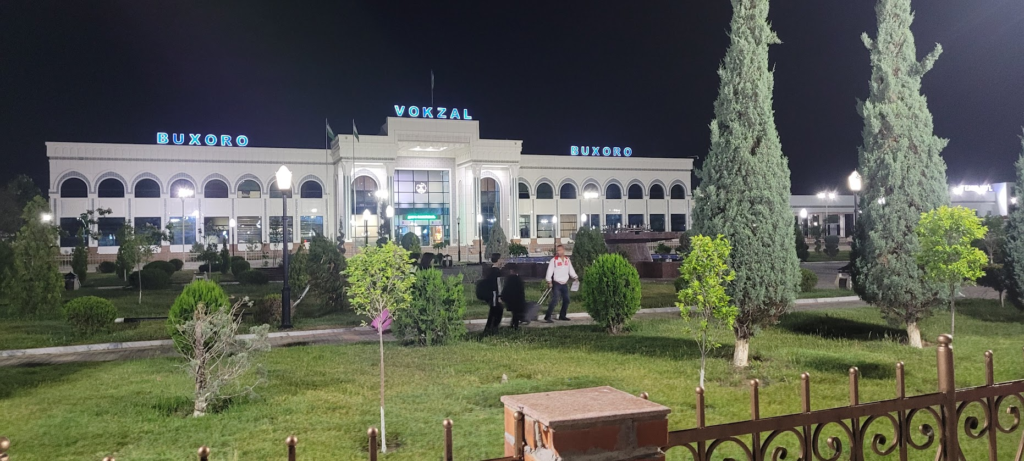
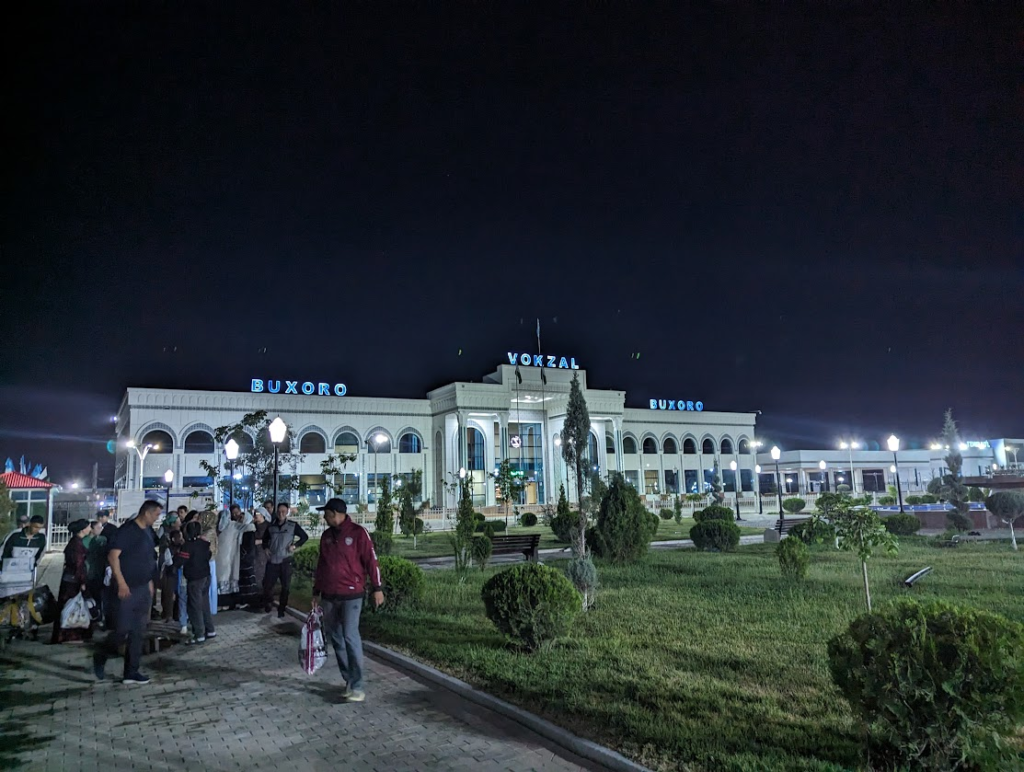
We checked into Kukaldosh Hotel, a boutique hotel, located in the heart of old Bukhara city. Very small hotel, but the rooms were really nice.
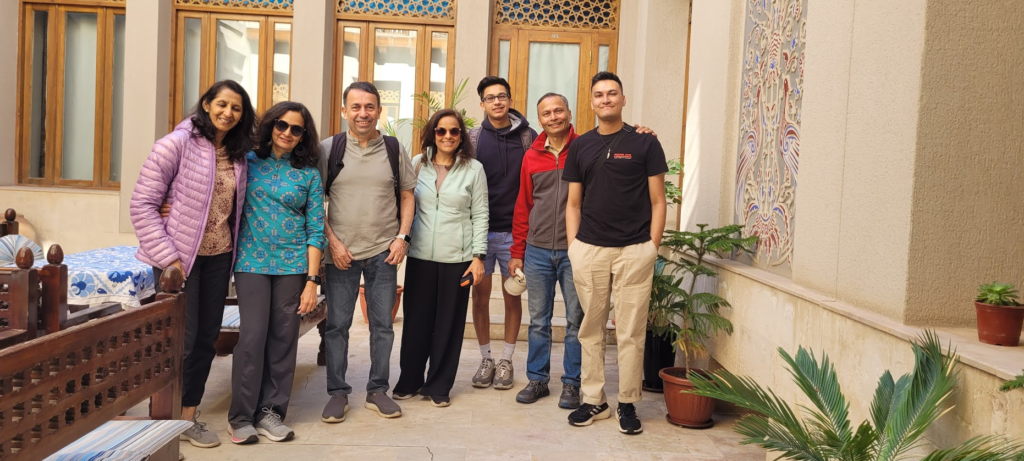
Day 4: Mon, May 20, 2024: Bukhara
Our hotel was about 150 ft from the main sights in Bukhara. We started our tour with our guide Behruza, a lady of Tajik descent. There are many Tajiks in Bukhara and Samarkand, because those cities were ruled by Tajik rulers. Unlike Tashkent, Bukhara and Samarkand are very historic and ancient cities. These were the centers of power.
The first stop was the Kukaldosh Madrassa. It was built in 1569 on the orders of Kulbaba Kukeltash, a high ranking official & a well-known philanthropist. Our guide said that he ran the secret service (spy organization).
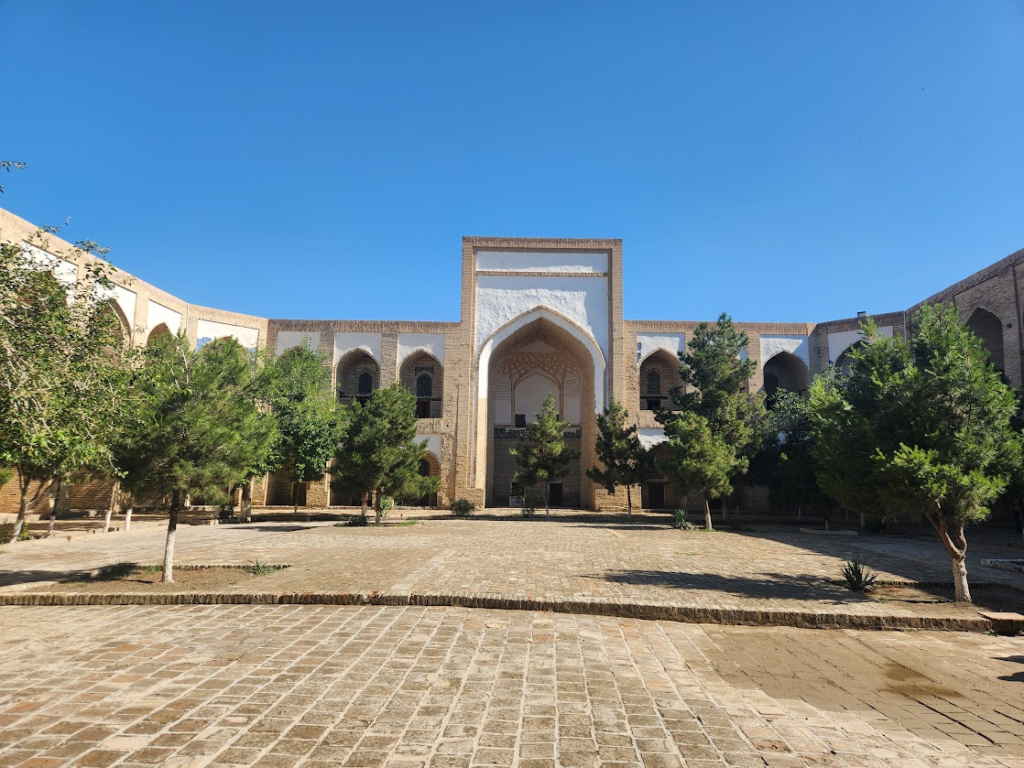
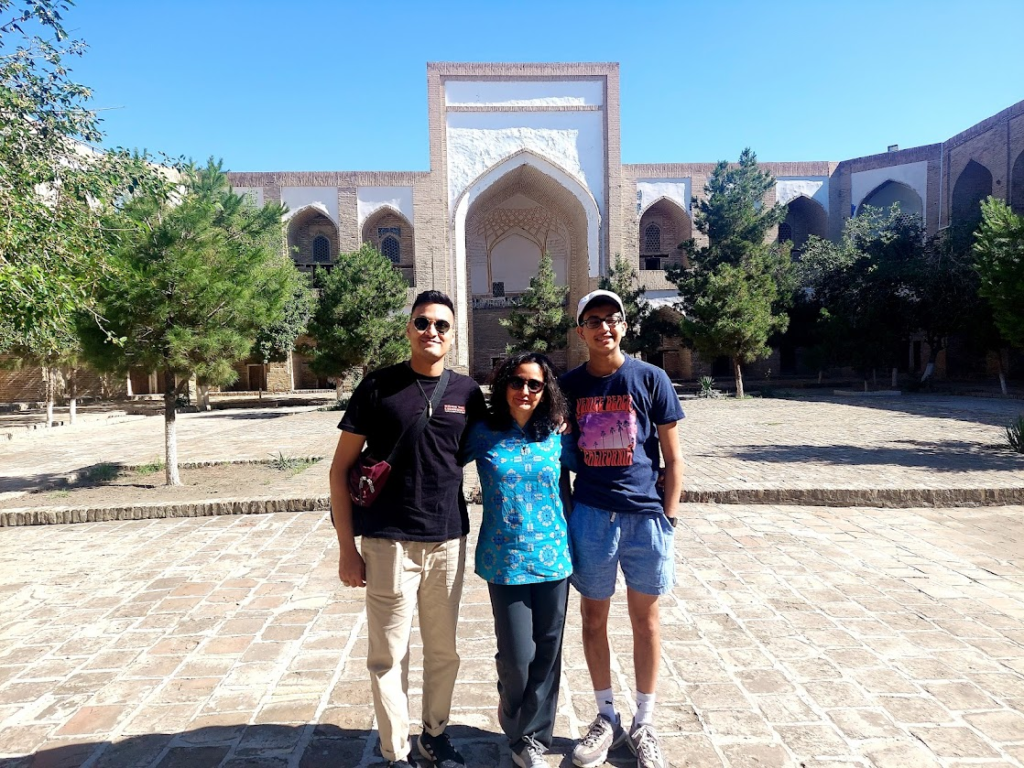
We stopped briefly to shop for Uzbek souvenirs and clothes.

Next stop was the Nadir Diwan Begi Madrassa. It was built between 1622 and 1623 by Nadir Devanbegi, the minister of the Bukhara Khan, Imam Quli Khan.
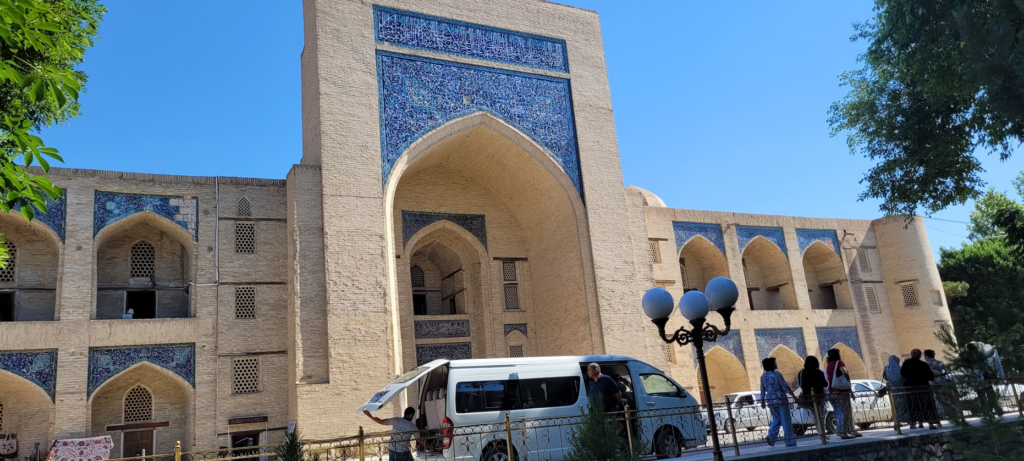
On the engravings, there are two birds. In Islam, the depiction of people and animals is prohibited. So Nadir Diwan Begi made the argument to the Mullas that the picture represents the Phoenix which is an imaginary bird. Hence, this was allowed. Nice workaround!

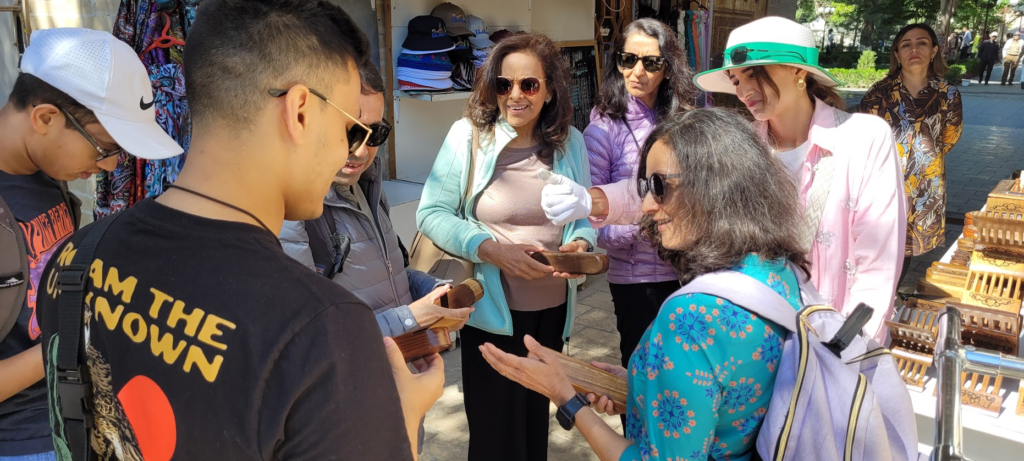
Just outside the Nadir Diwan Begi Madrassa was the statue of Mulla Nasiruddin Hodja. We and our kids had read stories of Hodja in Tinkle comics. Hodja is believed to have lived in the 13th century. Nasiruddin appears in thousands of stories, sometimes witty, sometimes wise, but in many of which he is also presented as a (holy) fool or as the butt of a joke. Uzbeks believe that he was from Bukhara.
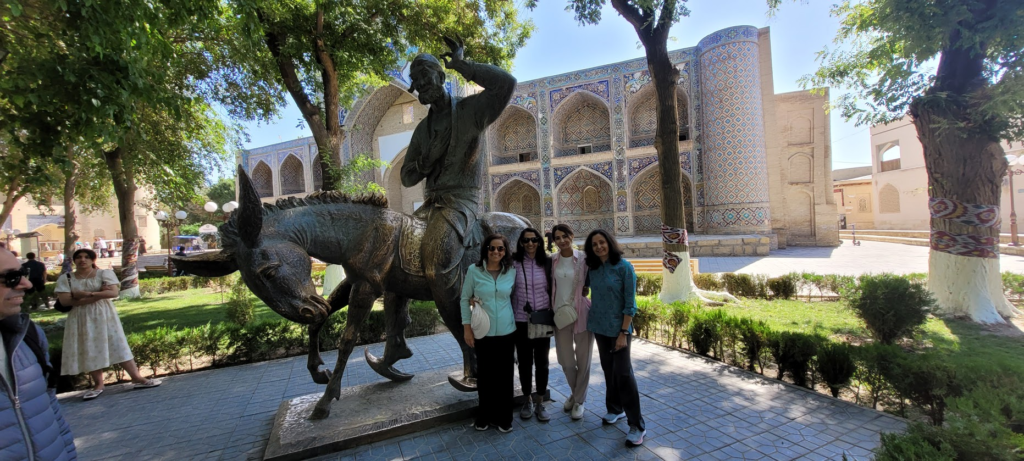
There was a large pond with the Nadir Diwan Begi Khanaka, a lodge built for sufis.
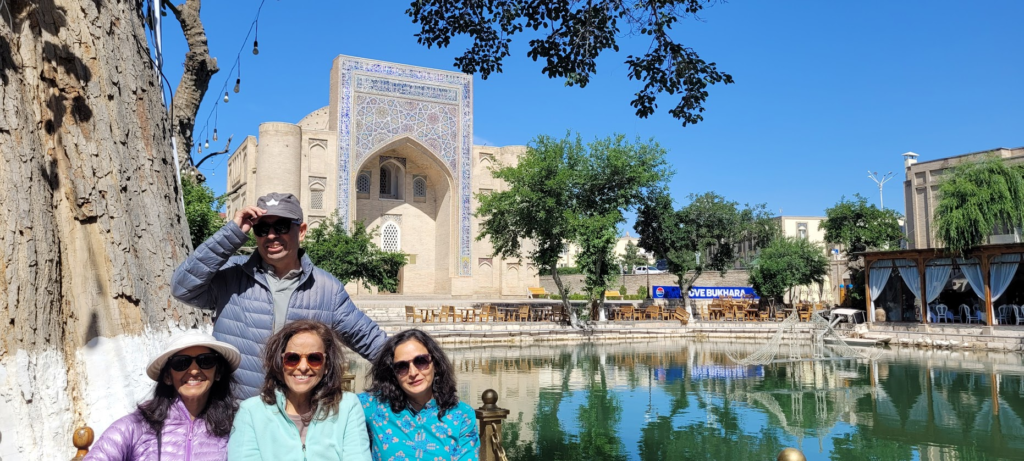
We walked around the old city area. There were a few other mosques and madrassa structures in Bukhara. The old city area is well preserved and vehicles are not allowed inside. So it is very comfortable to walk around.
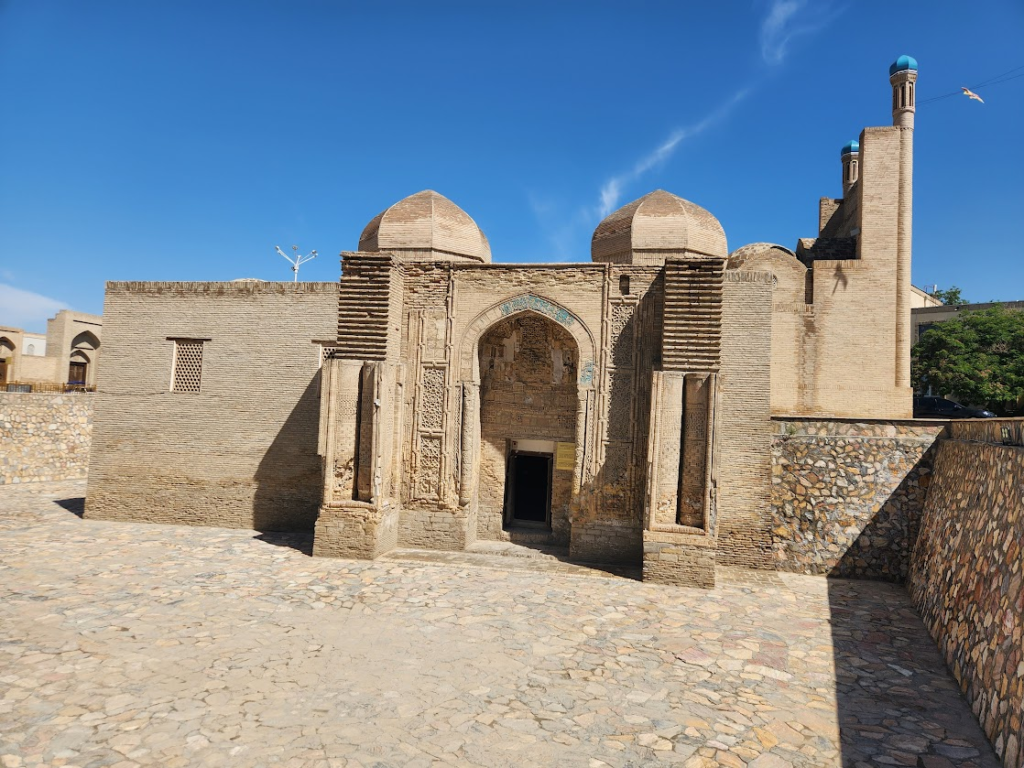
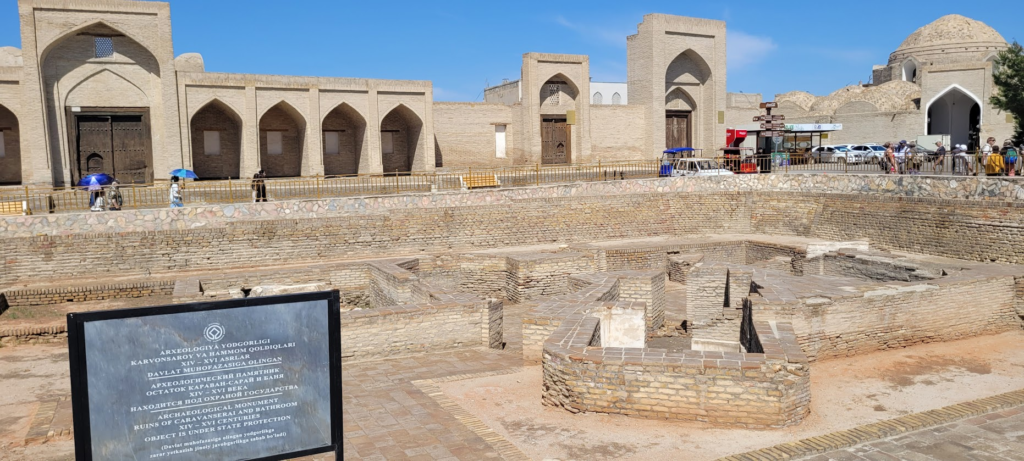
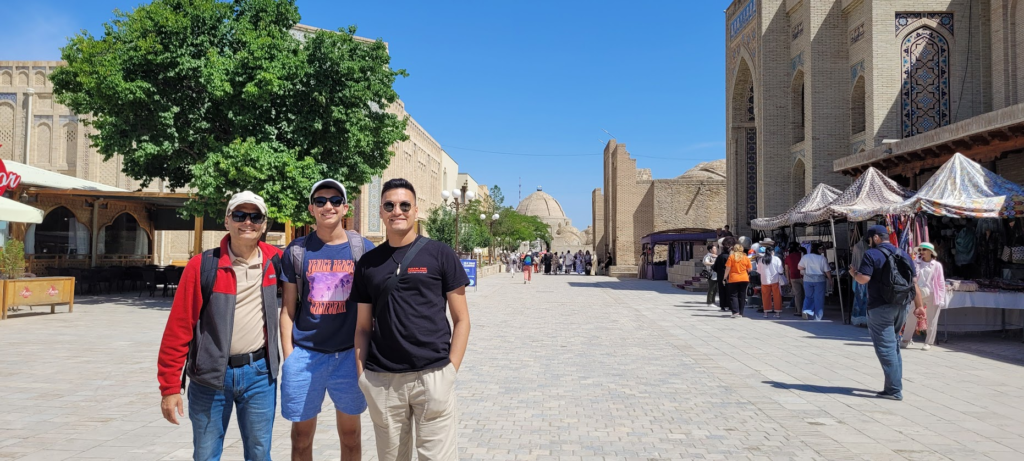
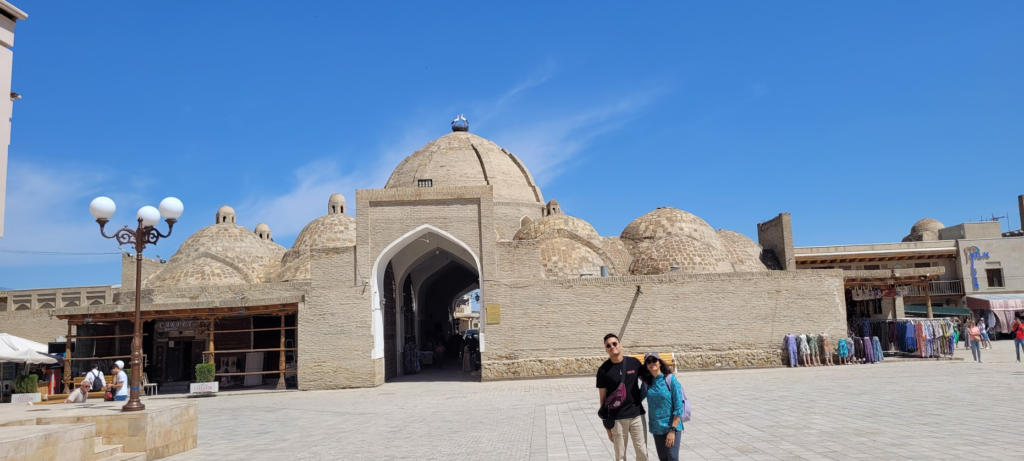
The Ulug Beg Madrassa was very interesting because of his interest in mathematics, astronomy and not just religious subjects.
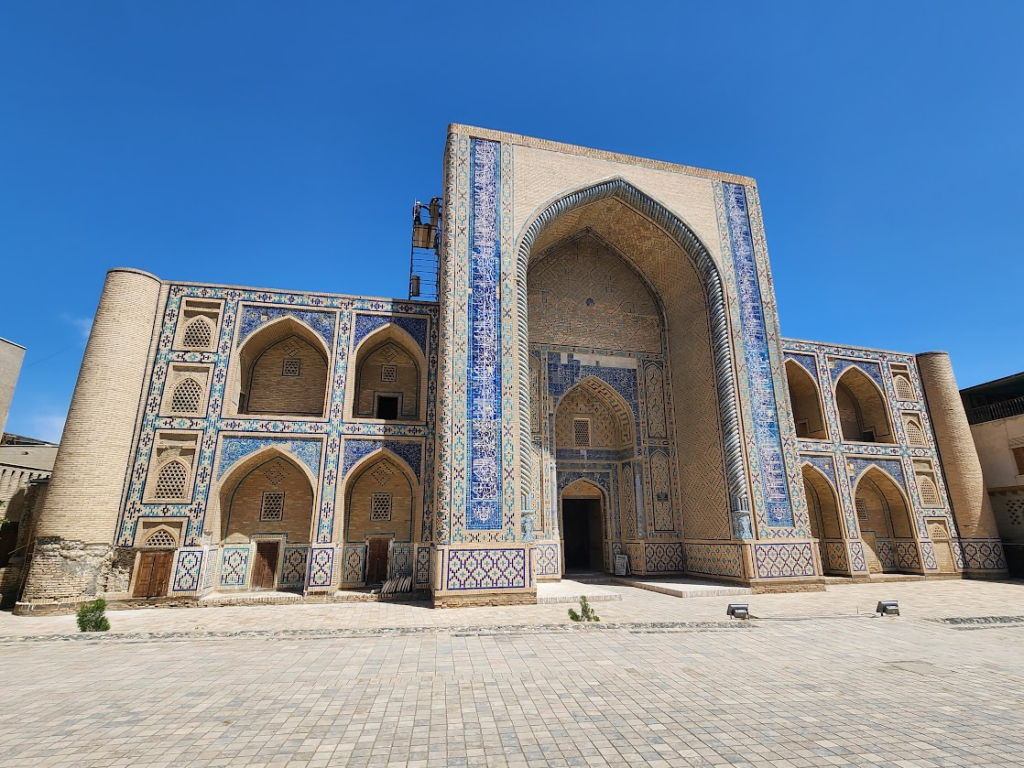

Next we saw the Kalon Tower, located in the Kalon mosque complex. Built in 1127, is made in the form of a circular-pillar baked brick tower, narrowing upwards. It is 150 feet tall and 30 feet in diameter at the base. There is a brick spiral staircase that twists up inside around the pillar to the rotunda. In times of war, warriors used the minaret as a watchtower to lookout for enemies.
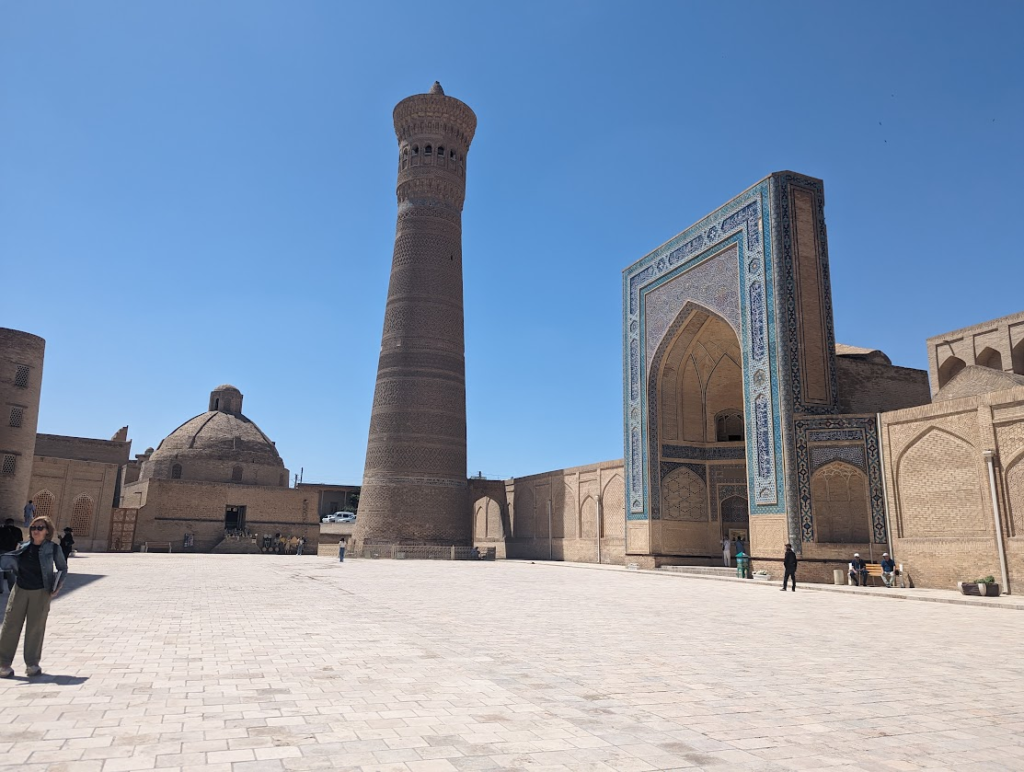
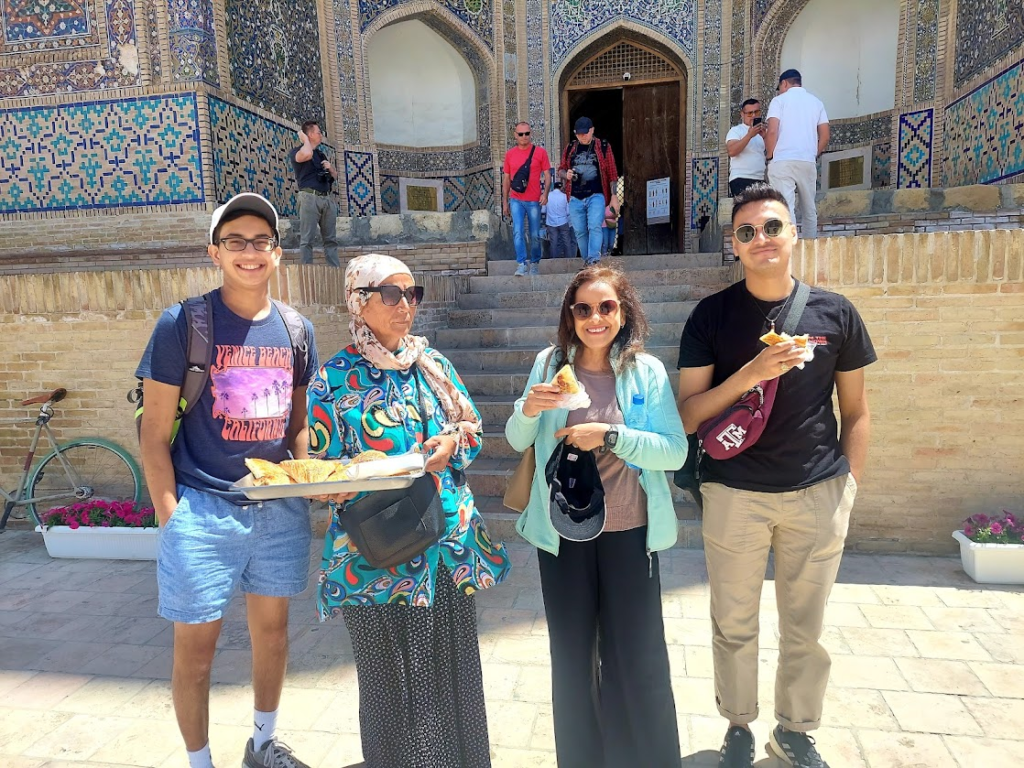
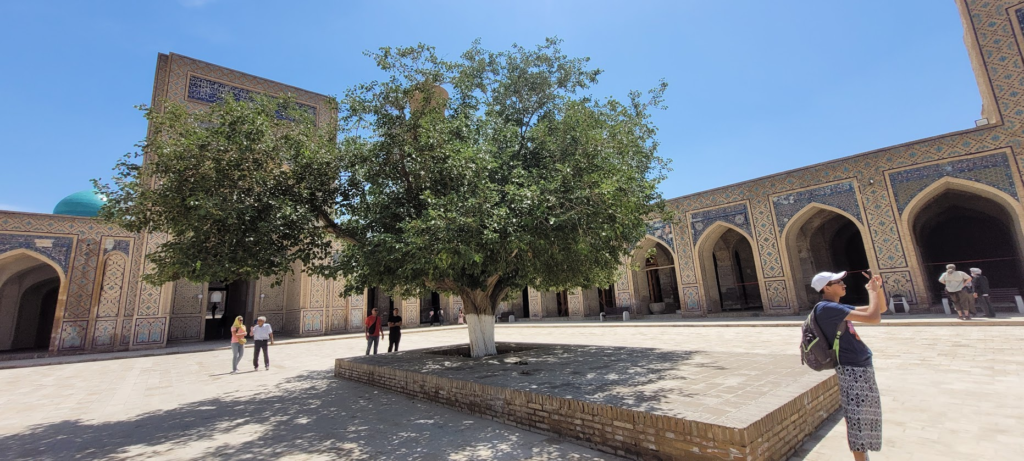
Next stop was the Ark of Bukhara, a massive fortress located in the city of Bukhara, Uzbekistan, that was initially built and occupied around the 5th century AD. In addition to being a military structure, the Ark encompassed what was essentially a town that, during much of the fortress’s history, was inhabited by the various royal courts that held sway over the region surrounding Bukhara.

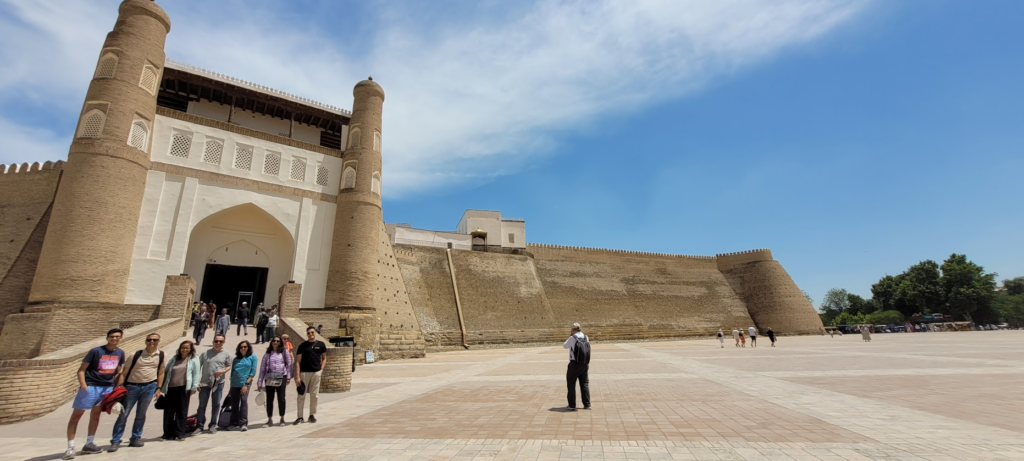
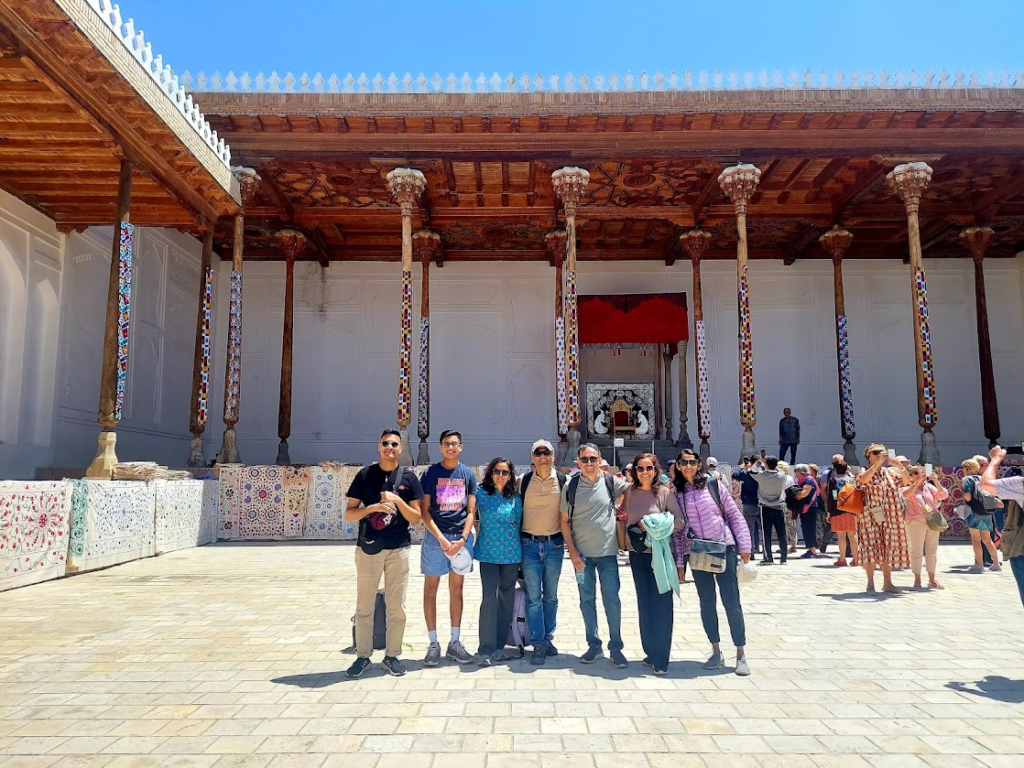
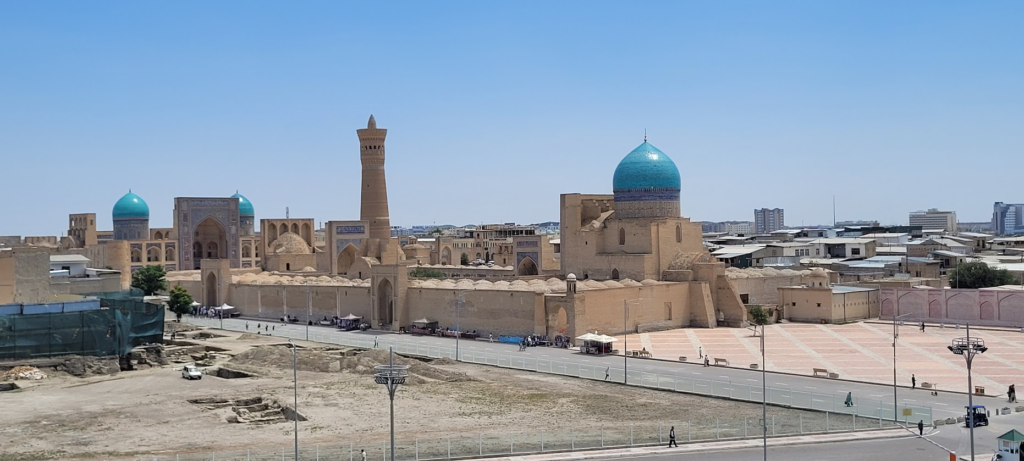
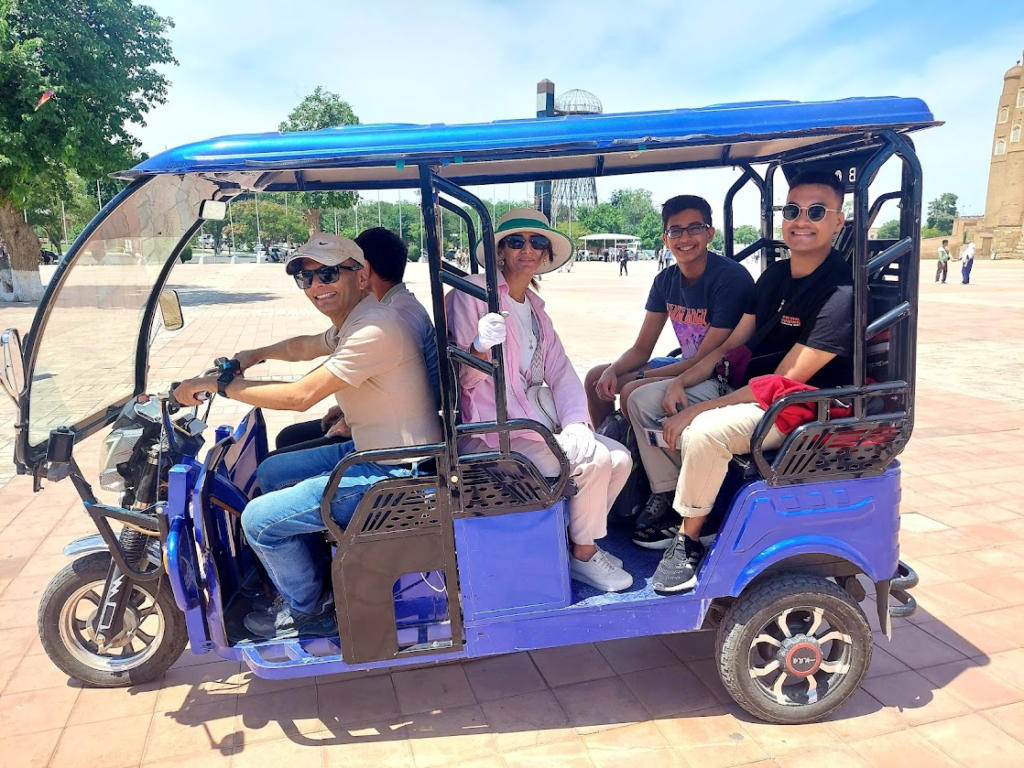
Next stop was Bolo Hauz Mosque. It served as a Friday mosque during the time when the emir of Bukhara was being subjugated under the Bolshevik Russian rule in the 1920s. Thin columns made of painted wood were added to the frontal part of the iwan (entrance) in 1917, additionally supporting the bulged roof of summer prayer room.
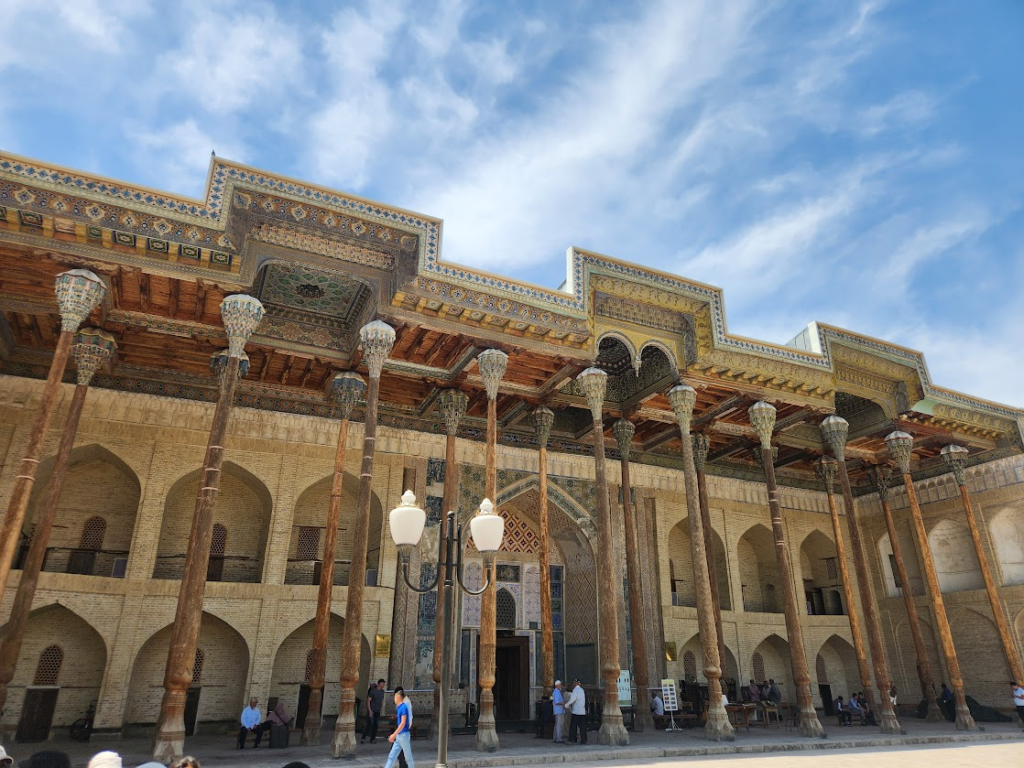
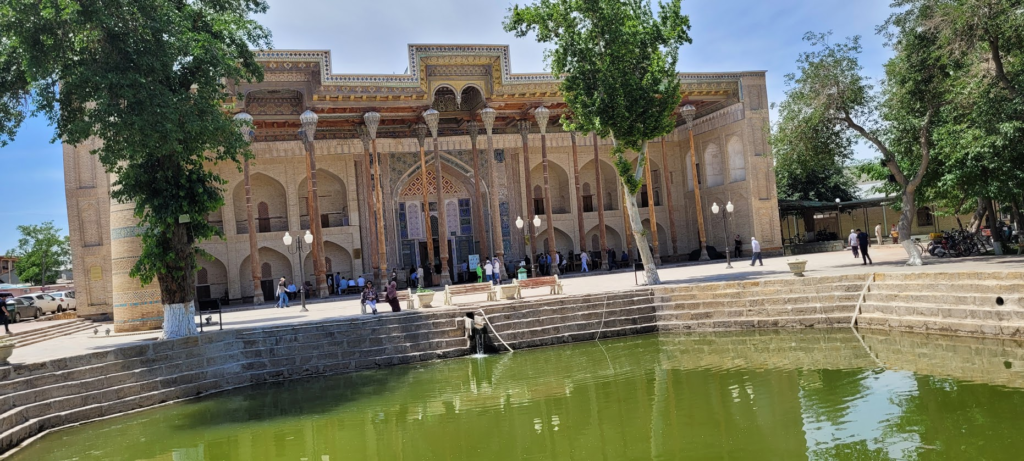
The last stop for the day was the Samanid Mausoleum located in the northwestern part of Bukhara, Uzbekistan, just outside its historic center. It was built in the 10th century AD as the resting place of the powerful and influential Islamic Samanid dynasty that ruled the Samanid Empire (people of Persian and Tajik descent) from approximately 900 to 1000 AD. The mausoleum is considered one of the iconic examples of early Islamic architecture and is known as the oldest funerary building of Central Asian architecture. The Samanids established their de facto independence from the Abbasid Caliphate in Baghdad and ruled over parts of modern Afghanistan, Iran, Uzbekistan, Tajikistan, and Kazakhstan.
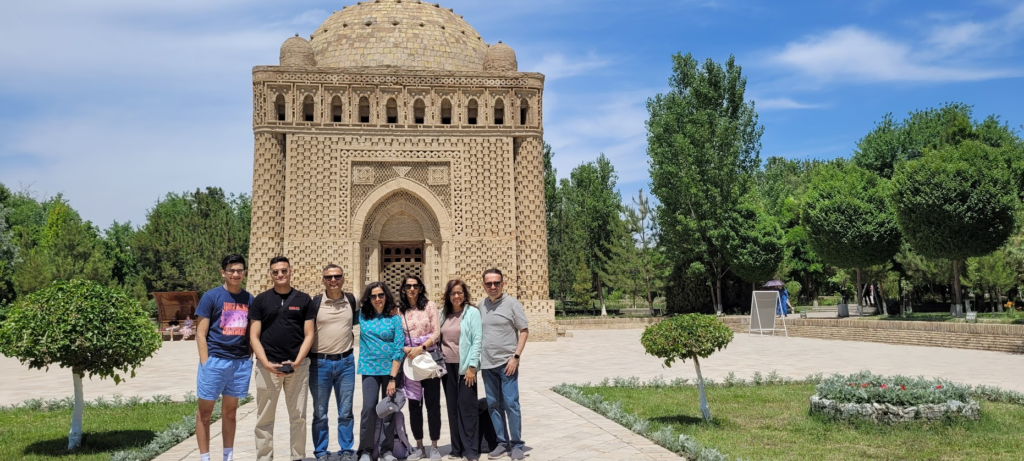
This was our final stop in Bukhara. We got a quick bite.

We picked up our bags from Kokaldosh Hotel and headed to Bukhara Railway station, where we had a train to catch at 6.30 pm.
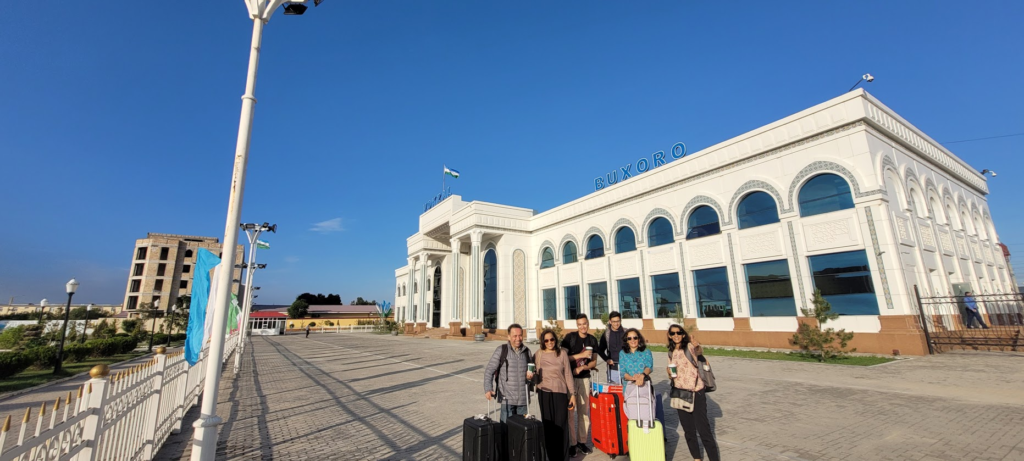
We reached Samarkand at around 9.30 pm and checked into the Hanifa Boutique Hotel.
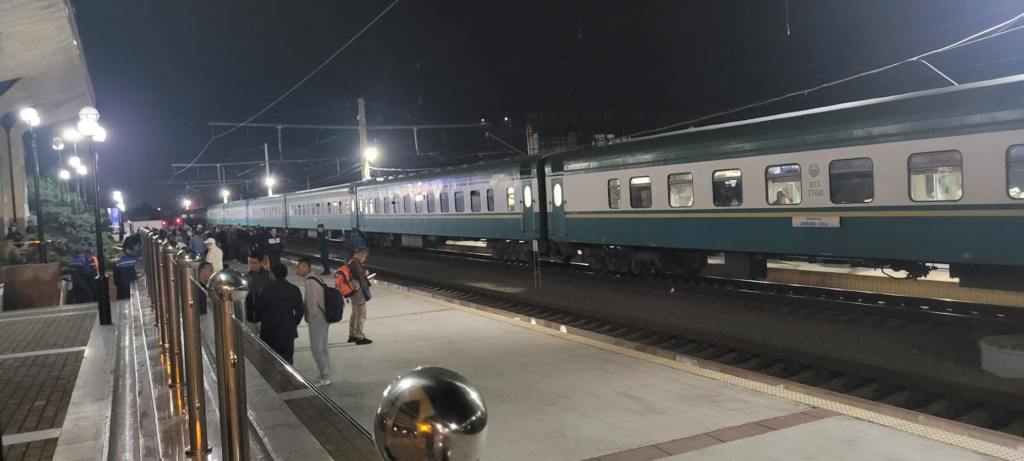

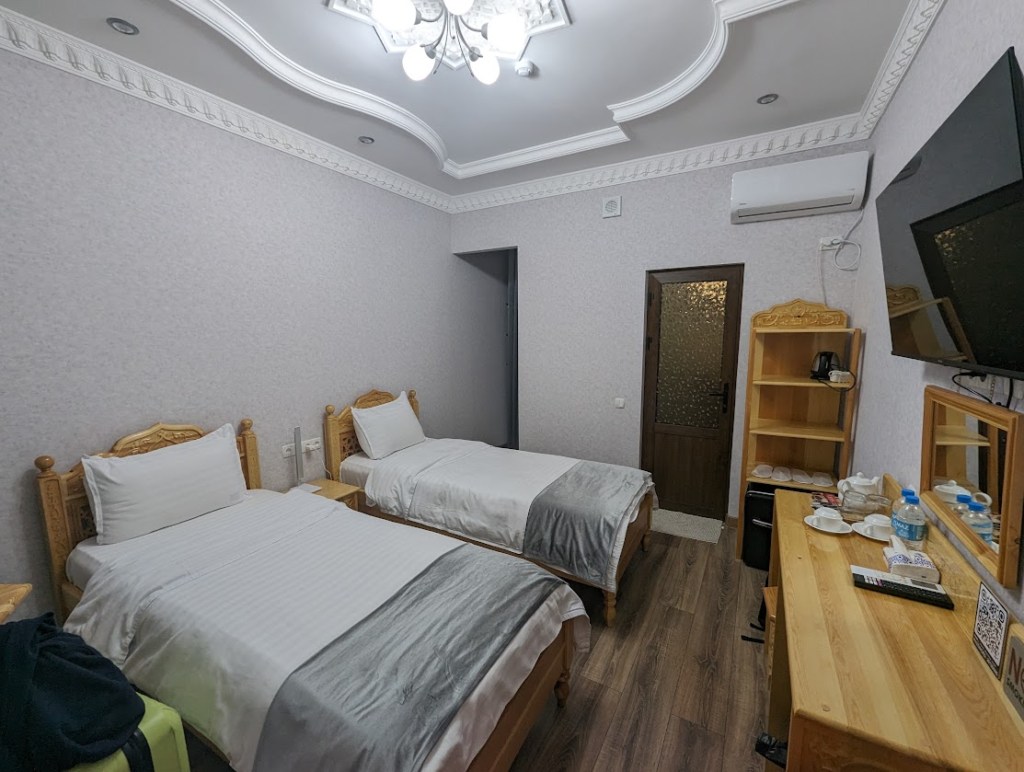
Day 5: Tue, May 21, 2024: Samarkand
We decided to start our day in Samarkand at 8 am where we had a sumptuous customized breakfast. They had something extra for vegetarians. Yash always preferred sleep over breakfast 🙂
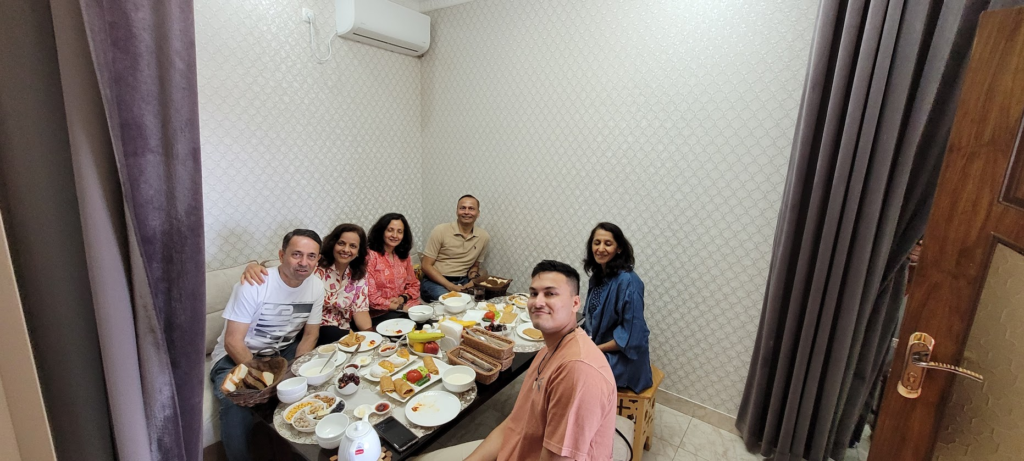
The name of our guide was Alexander, or Iskander. He was 70 years old, but very active and energetic. We started at about 9 am from our hotel.
Our first stop was Registan. Registan (means desert) was the heart of the city of Samarkand of the Timurid Empire. The Registan was a public square, where people gathered to hear royal proclamations, heralded by blasts on enormous copper pipes called dzharchis — and a place of public executions. It is framed by three madrasahs (Islamic schools) of distinctive Persian architecture. The square was regarded as the hub of the Timurid Renaissance. The three madrasahs of the Registan are the Ulugh Beg Madrasah (1417–1420), the Sher-Dor Madrasah (1619–1636), and the Tilya-Kori Madrasah (1646–1660).

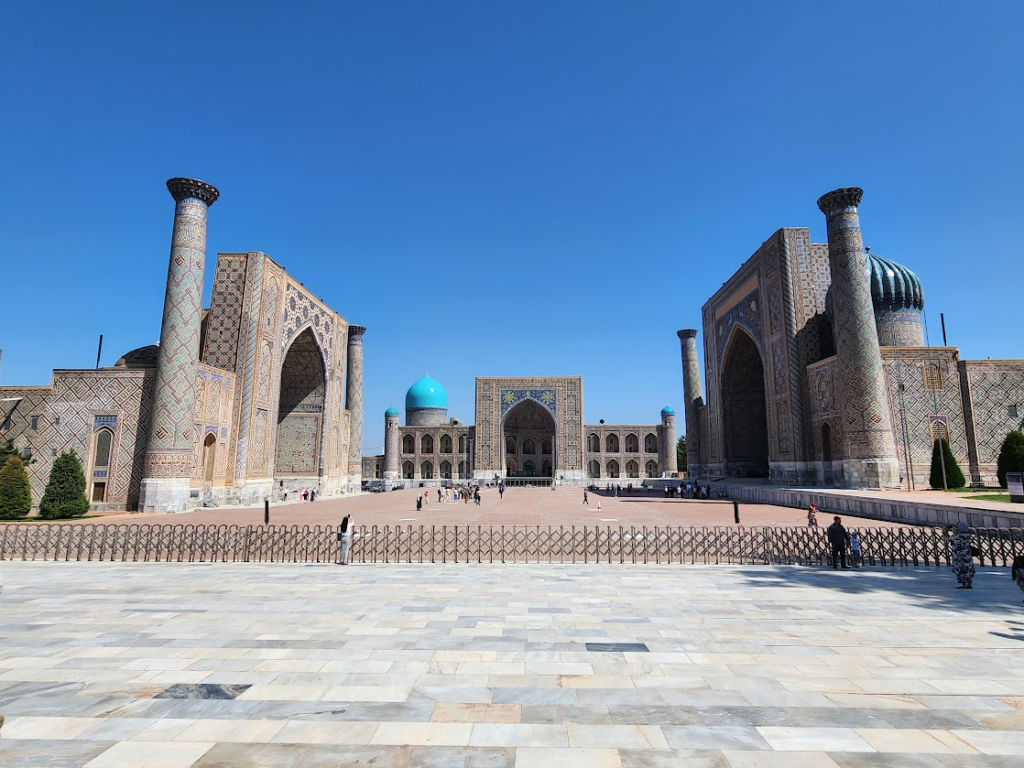
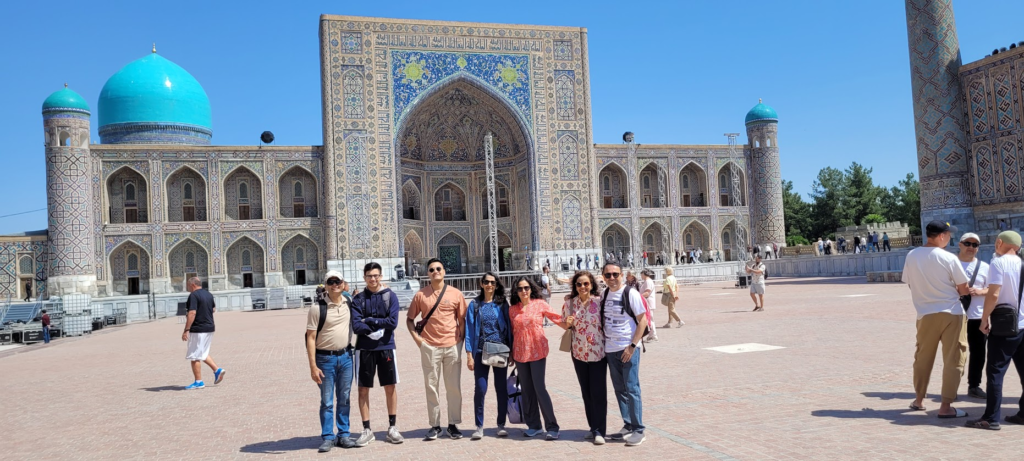

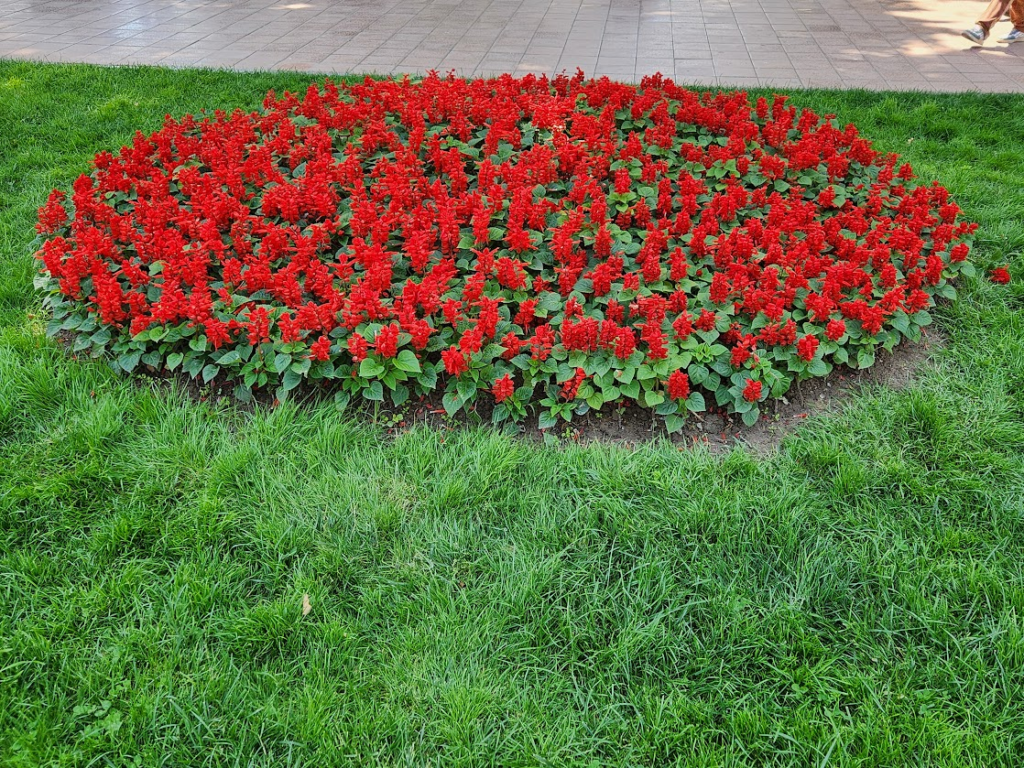
We stopped by the local bazar to exchange money and buy some souvenirs.
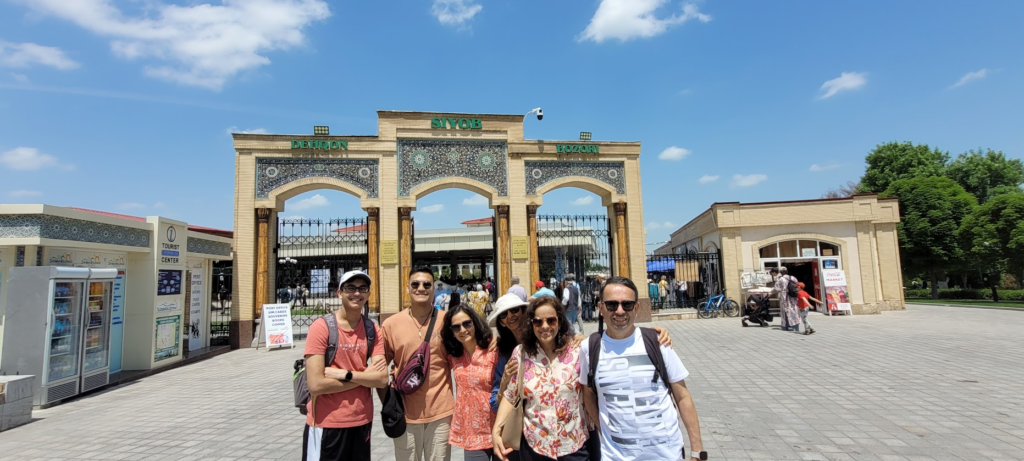
Our lunch was at a roadside tea house. The food was good and the service was really quick.
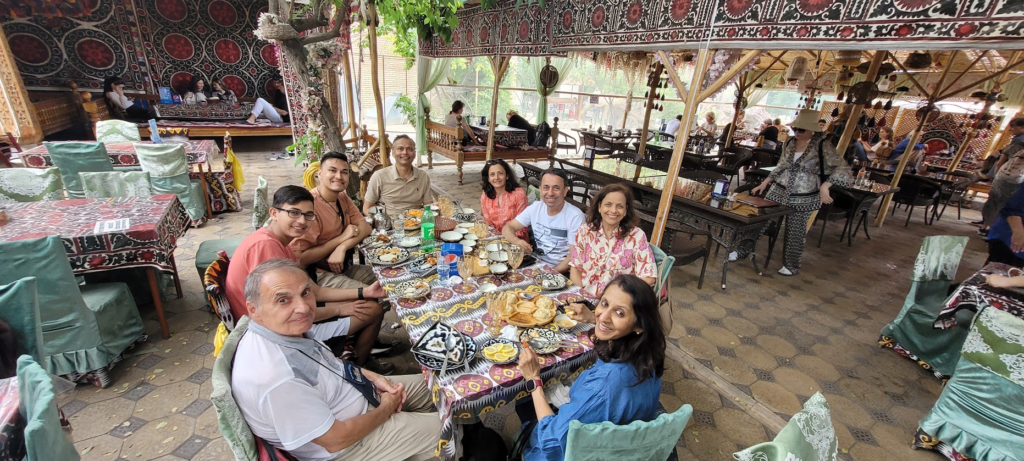
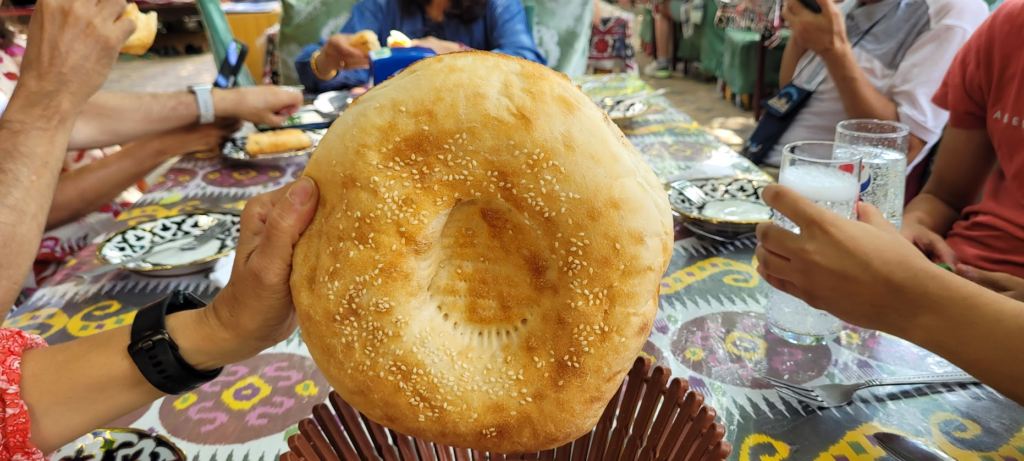
From Registan square, we walked over to Shah-i-Zinda (The Living King), an ensemble that includes mausoleums and other ritual buildings of 11th – 15th and 19th centuries. The complex was very nice and had some ornate buildings.
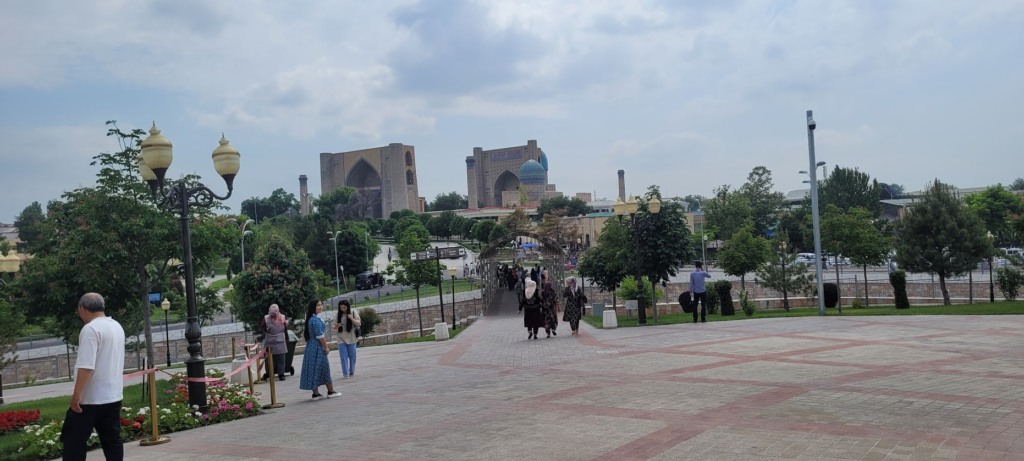




We proceeded to the Ulugh-beg Observatory which was built in the 1420s by the Timurid astronomer Ulugh Beg. This school of astronomy was constructed under the Timurid Empire, and was the last of its kind from the Islamic Medieval period. Islamic astronomers who worked at the observatory include Jamshid al-Kashi, Ali Qushji, and Ulugh Beg himself. The observatory was destroyed in 1449 and rediscovered in 1908.

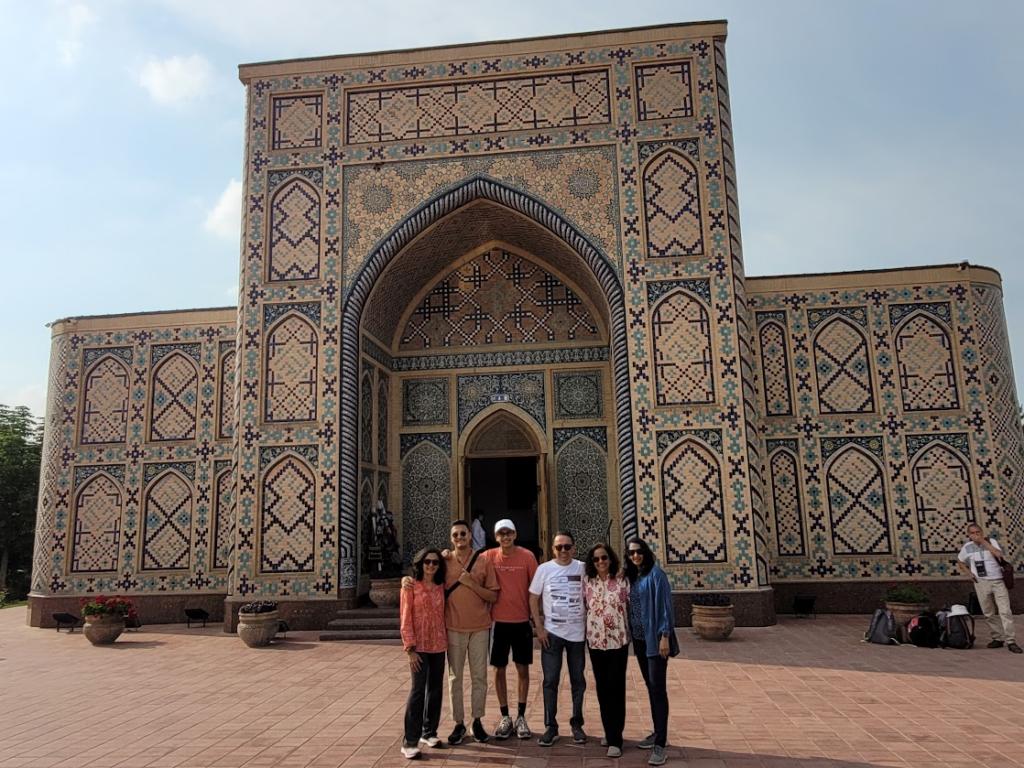

The final stop was the Amir Timur Masoleum that occupies an important place in the history of Central Asian architecture as the precursor for and had influence on later Mughal architecture tombs, including Gardens of Babur in Kabul, Humayun’s Tomb in Delhi and the Taj Mahal in Agra.
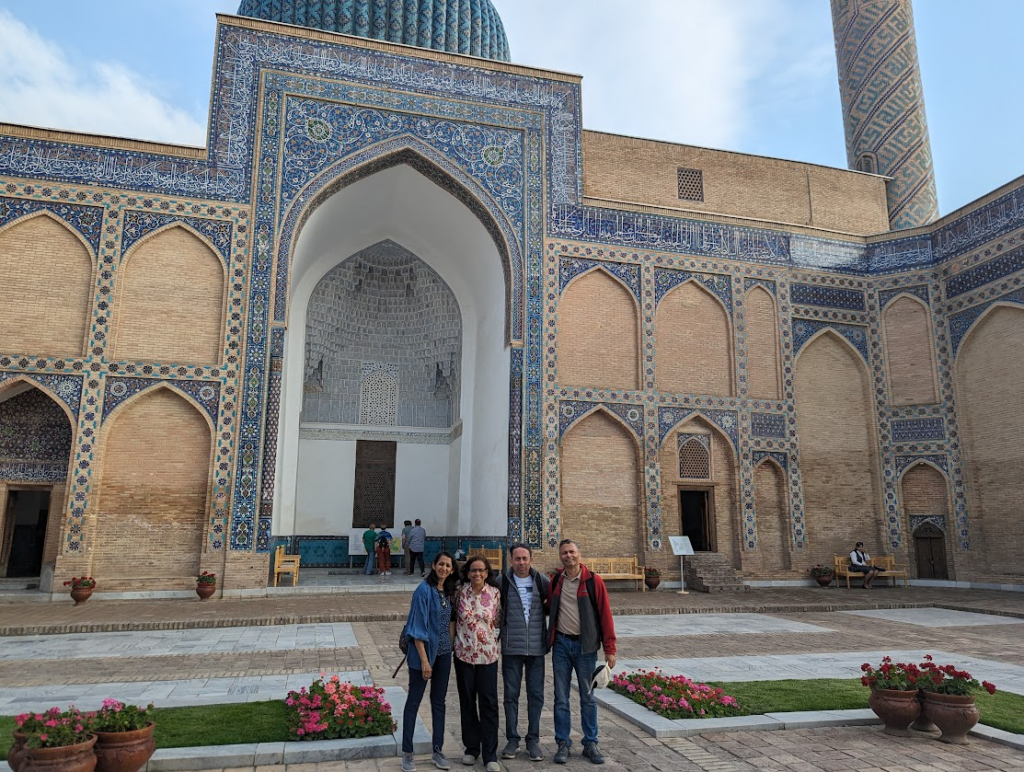

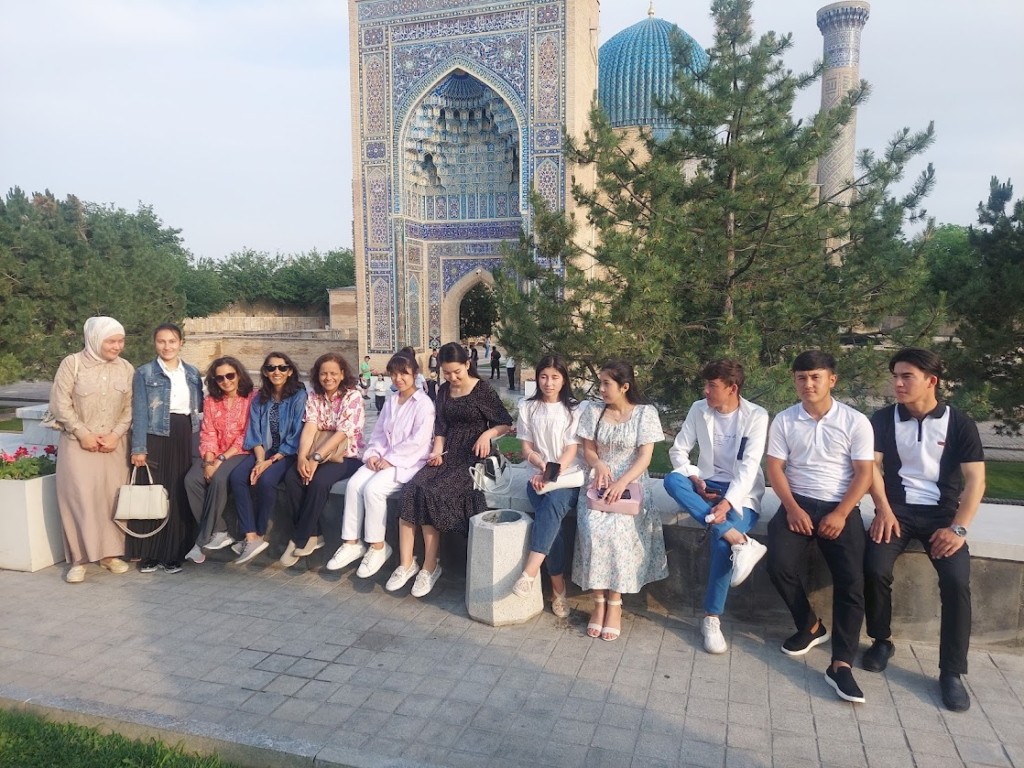
We headed back to the hotel after the Amir Timur mausoleum. In the evening, we had bought tickets to a cultural show that depicted Uzbek life, love, courtship, marriage, kids etc. It was at Registan square. It was a great 1 hour event. There was some dancing at the end.
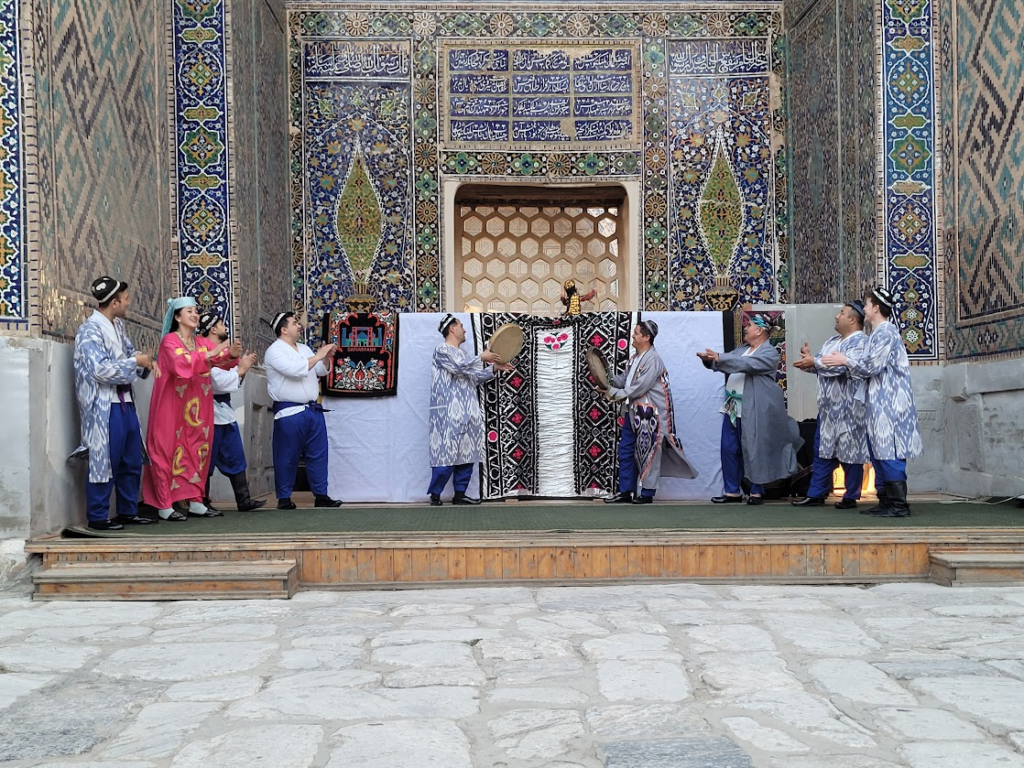
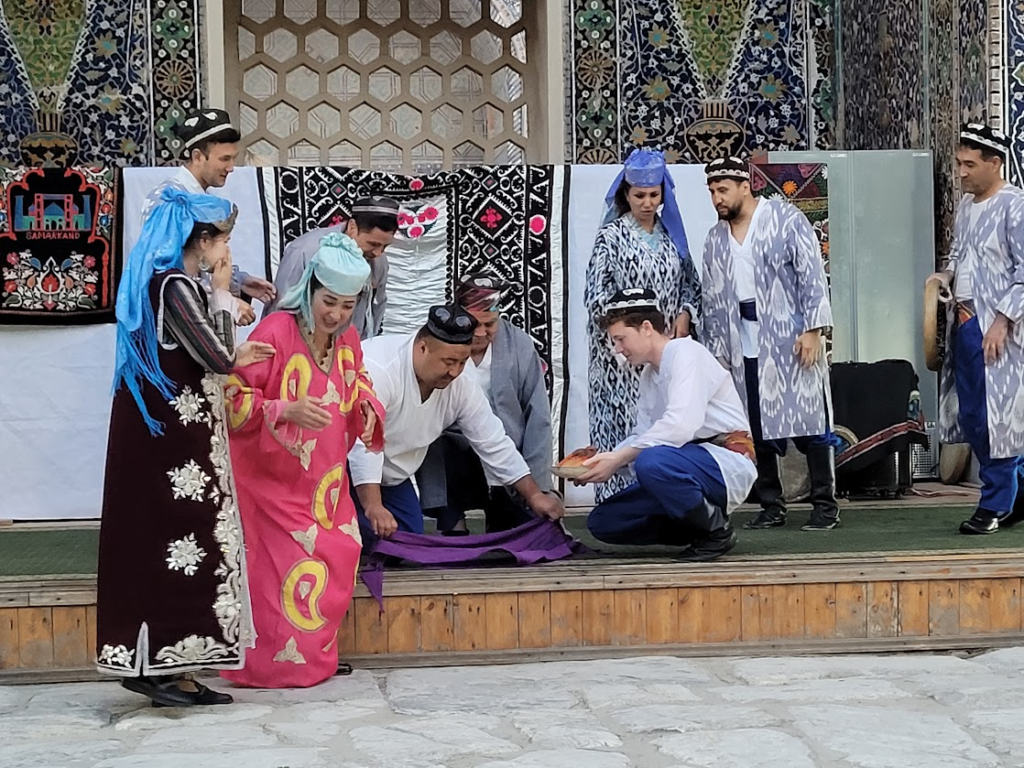
The show was quite nice and they invited everyone to participate in the dancing at the end of the show. So we joined in.
As we exited the cultural event, the lights had come on in Registan square and we got some great views of this iconic sight in Samarkand.
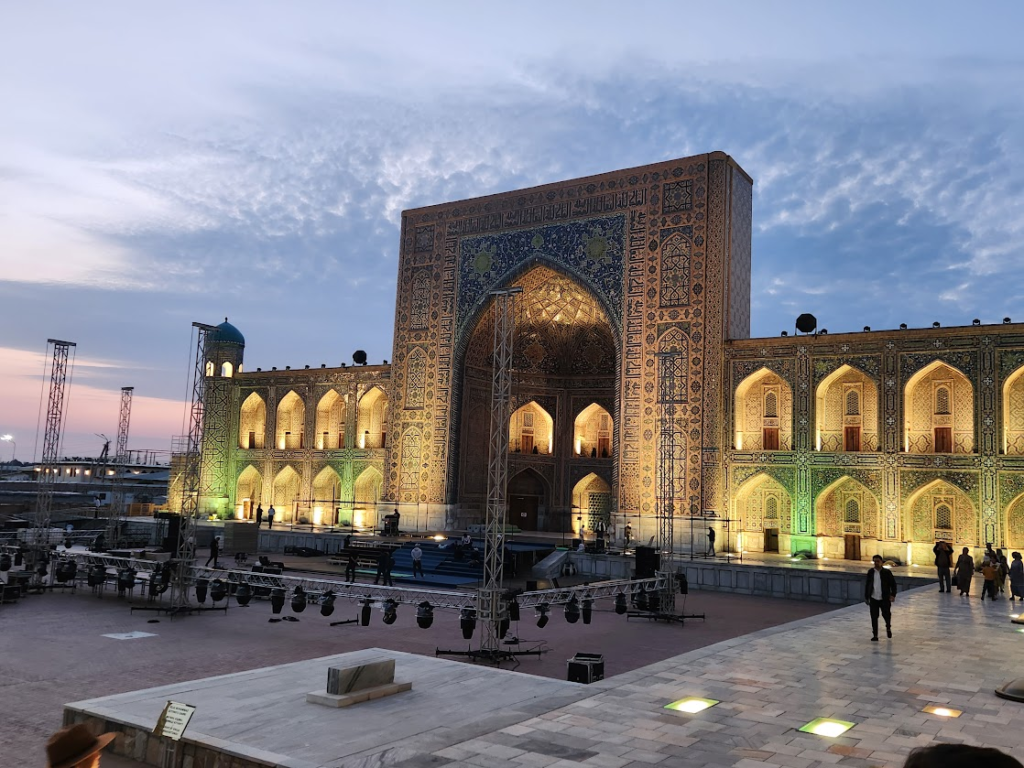
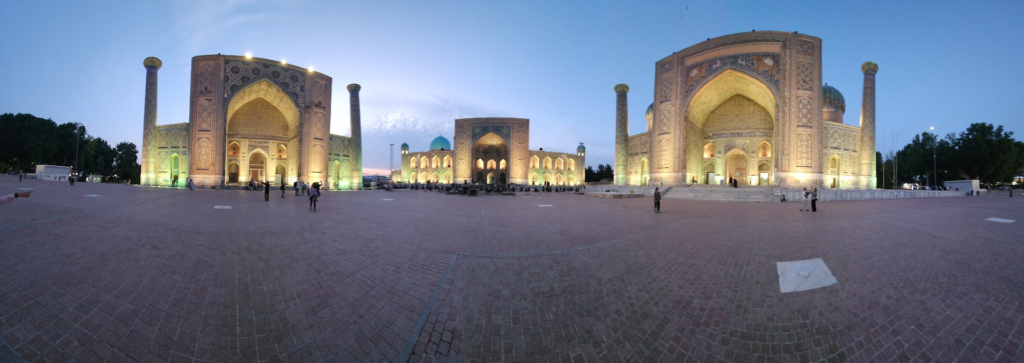

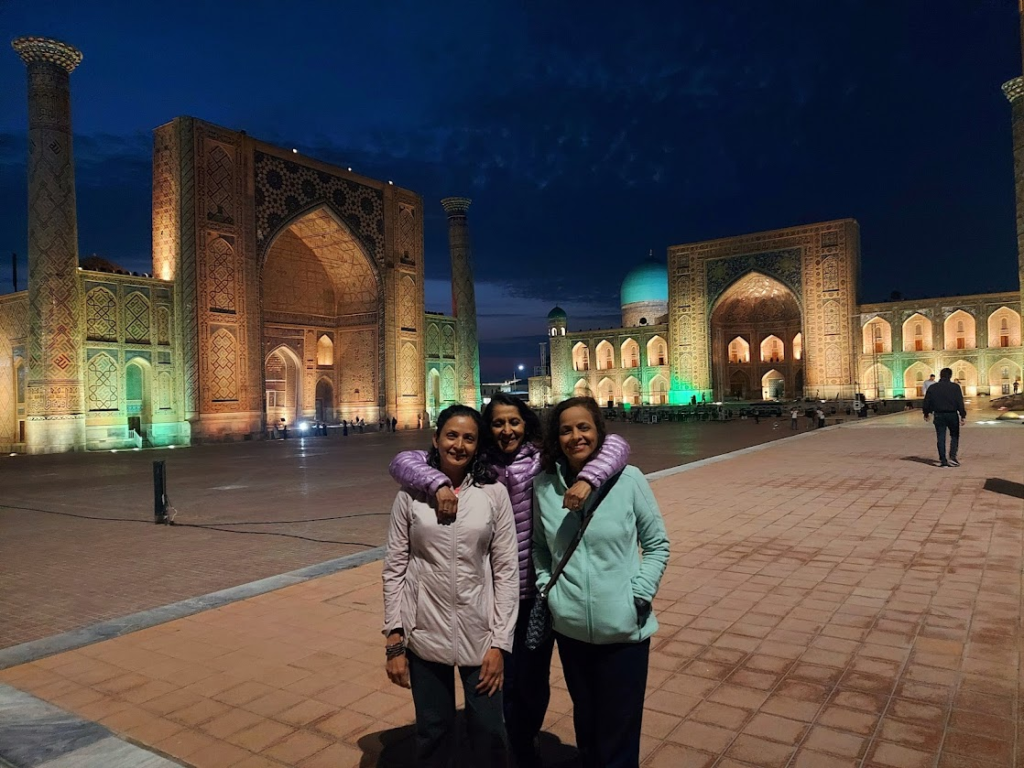

This was our last night in Uzbekistan. We headed back to the hotel at around 9 pm.
The next day, we were planning to go from Samarkand, Uzbekistan to Dushanbe,Tajikistan by road using the the Penjakent border crossing. Hanifa Boutique hotel were extremely helpful and arranged transportation from the hotel to the Uzbek side of the Penjakent crossing for $50 total, a very reasonable price. Overall, we were very happy with the personalized service provided by Hanifa Boutique hotel, and it was truly gracious, not as if they were out to get your money.
We woke up on Wed, May 22 and proceeded from Samarkand to the land border crossing at 8 am. This was the end of our wonderful 6 day Uzbekistan trip.
This trip was a part of a larger Central Asia 17 day itinerary which covered Uzbekistan, Tajikistan, Kazakhstan and Kyrgyzstan. Click here if you are interested to read about the entire itinerary.








Nice trip. Hope to meet you in Washington DC.